#I thought they took place in the 1960s at the earliest
Explore tagged Tumblr posts
Text
Let me tell you the story of a very dumb 90s kid (and the not-so-bright adult that kid grew into).
I, like a lot of 90s kids in US, read The Boxcar Children in 3rd grade. I got supper excited when I found out it was a series and probably spent more on them at Scholastic Book Fairs than my parents did on my braces.
But there was something that always confused me about the first book. In the original Boxcar Children book, the kids are given a ride by a couple who drive a horse and buggy. And there are frequent references to water fountains for horses and generally that horse-drawn transportation was a mainstay.
And then at the end of the book, the rich grandfather shows up and he’s driving a station wagon.
Now, you would think that even if 8-year-old me was confused about this, adult me would have assumed the book took place in a time where automobiles were only just coming into use. The couple at the beginning were poor bakers who had to use a cart and rich Mr. Alden could afford a fancy car.
And on a certain level, I understood that was probably the case.
But here’s the thing. The edition I grew up reading looked like this:

What about this entire cover even remotely says “this book is set in 1924”?
I’m furious. Because if someone had handed me an edition that looked like this:
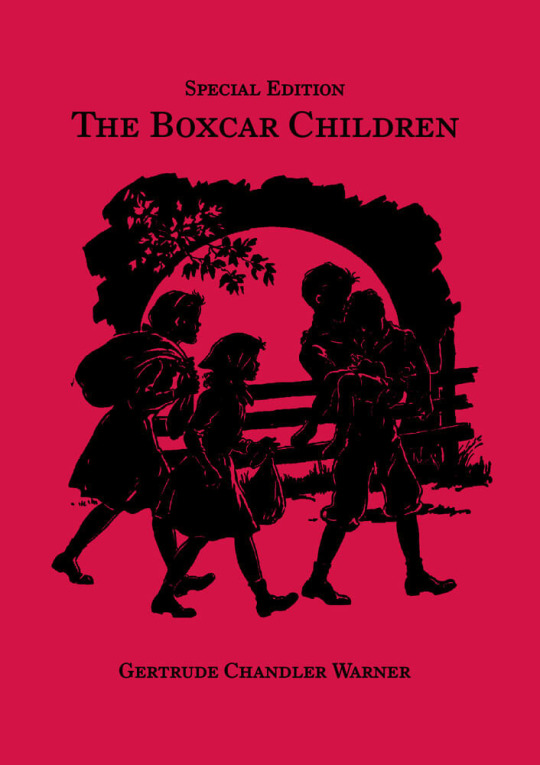
Then obviously my 8-year-old brain (and subsequent adult thembo one) would know this book was set MORE THAN 70 YEARS PRIOR.
I do think they used some of the original illustrations on the inside. And maybe that should have provided context, but honestly I think it just made me more confused.

But also, they were still coming out with new Boxcar Children Mysteries and I was regularly blowing all my Scholastic Book Fair money on these:
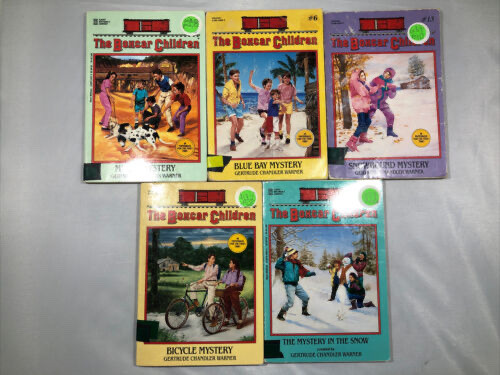

Which again, all 90s looks for the kids on the covers and all illustrations on the inside were also super 90s.
I also think that something that contributed to my initial confusion was the fact that I didn’t think station wagons were that old.
I was picturing this:

Not this:

I do now know that most of those old kids mystery series were rebooted and rebranded every generation. Nancy Drew books even got regular rewrites to make her closer to whatever that decade would think a cool, stylish, liberated teenage girl look like. But when I was just a kid, I came up with my own explanation:
I decided they must be Amish. Think about it— we never knew what happened that drove the wedge between Old Mr. Alden and his son. What if the kids’ dad fell in love with an Amish girl, renounced his claim to the family fortune and ran away to marry her? Then they died and the children found the society too harsh and repressive and ran away to escape!
But also… I am more than a bit embarrassed because it took me 25 YEARS to wrap my head around something from a book they teach 3rd graders.
#the boxcar children#1990s#90s kid#I am an idiot actually#I thought they took place in the 1960s at the earliest#I mean look at Jessie’s jumpsuit!!!!
13 notes
·
View notes
Text
“After the band broke up, the Beatles industry took off; John’s murder predictably intensified this acceleration. More books, more photographs, more exposés, all of which potentially swayed fans to forget one’s private experience of the band and identify with whatever published history most suited them. But the opposite was also true.
The contested truths about the band, especially who wrote what, along with the intricacies of the recording sessions, elevated Beatles criticism to a new level, and for a certain type of fan, the close textual analysis of Beatles songs, including discussions of psychological differences that could explain artistic differences (e.g., John is “horizontal,” Paul is “vertical”), enhanced their private feelings about the band.
“There’s a Place” is an early Beatles song that asserts the value of privacy. The “place” is John’s mind, where “there’s no time / when I’m alone.” Sung with great insistence and piercing harmony, for many male critics this song is loaded with significance beyond the usual romantic concerns its lyrics imply, for instance, being blue.
For Ian MacDonald, the song represents “a young man’s . . . assertion of self-sufficient defiance.” Steve Turner hears the lyrics as a search for “comfort,” while Tim Riley insists on the song’s “innocence.” For Geoffrey O’Brien, the song is a “stand in for the overall value of the Beatles . . . [a] sonic environment [that] turned out to be an excellent cure for too much thinking.” Robert Christgau hears John’s “ability to transcend the isolation he dreads.”
Initially, I didn’t know what to make of such serious regard for this song. You certainly can’t dance to it, and it’s quite short. It’s one of those quirky Beatles songs that defies category. John dismissed it outright, yet it’s impossible to separate John from the song’s impact because it’s his mind we’re going into.
The song’s title also invites us into a literal place, John’s small, front-facing bedroom in Aunt Mimi’s house. That room is the place of his earliest writings, his private thoughts, but also the place he frequently escaped from—to visit his mother, or to try his luck in Hamburg, and later to lay musical claim to the Cavern Club and a sexual claim to its female patrons. In 1960, after the group was kicked out of Hamburg, John, alone, penniless and dejected, returned to this narrow room. It was a young man’s room.”
How to Be a Beatles Fan Without Really Trying - Sibbie O'Sullivan on Privacy and Fandom (Excerpt from Sibbie O’Sullivan’s My Private Lennon: Explorations from a Fan Who Never Screamed)
#The Beatles#John Lennon#John#Sibbie O'Sullivan#My Private Lennon: Explorations from a Fan Who Never Screamed#quotes
24 notes
·
View notes
Photo
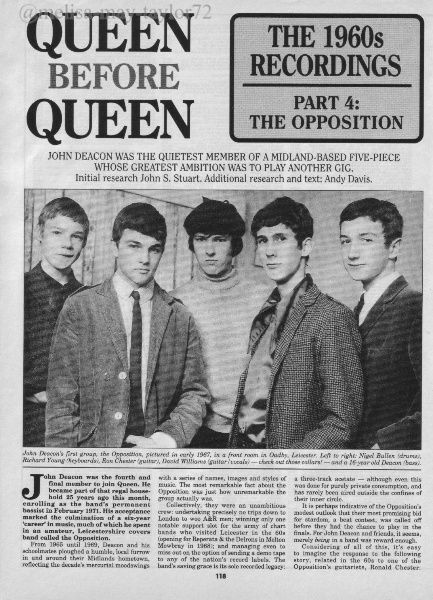
QUEEN BEFORE QUEEN
THE 1960s RECORDINGS
➖➖➖➖➖➖➖➖➖
PART 4:
THE OPPOSITION
JOHN DEACON WAS THE QUIETEST MEMBER OF A MIDLAND-BASED FIVE-PIECE WHOSE GREATEST AMBITION WAS TO PLAY ANOTHER GIG.
Initial research John S. Stuart. Additional research and text: Andy Davis.
John Deacon was the fourth and final member to join Queen. He became part of that regal household 25 years ago this month, enrolling as the band’s permanent bassist in February 1971. His acceptance marked the culmination of a six-year ‘career’ in music, much of which he spent in an amateur, Leicestershire covers band called the Opposition.
From 1965 until 1969, Deacon and his schoolmates ploughed a humble, local furrow in and around their Midlands hometown, reflecting the decade’s mercurial moodswing with a series of names, images and styles of music. The most remarkable fact about the Opposition was just how unremarkable the group actually was.
Collectively, they were an unambitious crew: undertaking precisely no trips down to London to woo A&R men; winning only one notable support slot for the army of chart bands who visited Leicester in the ‘60s (opening for Reperata & the Delrons in Melton Mowbray in 1968); and managing even to miss out on the option of sending a demo tape to any of the nation’s record labels. The band’s saving grace is its solé recorded legacy: a three-track acetate — although even this was done for purely private consumption, and has rarely been aired outside the confines of their inner circle.
It is perhaps indicative of the Opposition’s modest outlook that their most promising bid for stardom, a beat contest, was called off before they had the chance to play in the finals. For John Deacon and friends, it seems, merely being in a band was reward enough.
Considering of all of this, it’s easy to imagine the response to the following story, related in the ‘60s to one of the Opposition’s guitarists, Ronald Chester:...[ ]
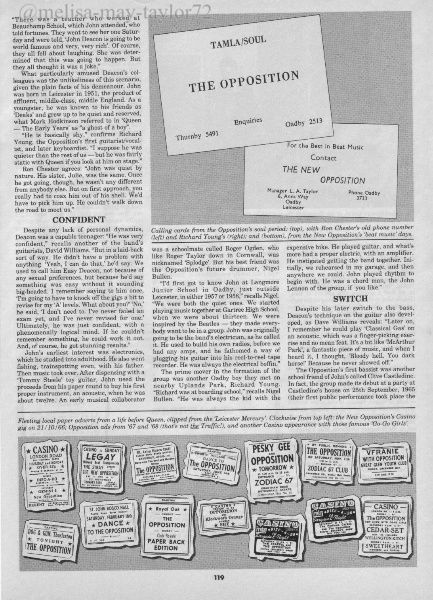
...[ ] “There was a teacher who worked at Beauchamp School, which John attended, who told fortunes. They went to see her one Saturday and were told, ‘John Deacon is going to be world famous and very, very rich. Of course, they all fell about laughing. She was determined that this was going to happen. But they all thought it was a joke."
What particularly amused Deacon’s colleagues was the unlikeliness of this scenario, given the plain facts of his demeanour. John was born in Leicester in 1951, the product of affluent, middle-class, middle England. As a youngster, he was known to his friends as ‘Deaks’ and grew up to be quiet and reserved, what Mark Hodkinson referred to in ‘Queen — ‘The Early Years’ as “a ghost of a boy".
“He is basically shy,” confirms Richard Young, the Opposition’s first guitarist/vocalist, and later keyboardist. “I suppose he was quieter than the rest of us — but he was fairly static with Queen if you look at him on stage.”
Ron Chester agrees: “John was quiet by nature. His sister, Julie, was the same. Once he got going, though, he wasn’t any different from anybody else. But on first approach, you really had to coax him out of his shell. We’d have to pick him up. He couldn’t walk down the road to meet us."
CONFIDENT
Despite any lack of personal dynamics, Deacon was a capable teenager: “He was very confident," recalls another of the band’s guitarists, David Williams. “But in a laidback sort of way. He didn’t have a problem with anything. ‘Yeah, I can do that’, he’d say. We used to call him ‘Easy Deacon’, not because of any sexual preferences, but because he’d say something was easy without it sounding big-headed. I remember saying to him once, I’m going to have to knock off the gigs a bit to revise for my ‘A’ levels. What about you?’ ‘No’, he said, ‘I don’t need to. I’ve never failed an exam yet, and I’ve never revised for one’. Ultimately, he was just confident, with a phenomenally logical mind. If he couldn’t remember something, he could work it out. And, of course, he got stunning results.”
John’s earliest interest was electronics, which he studied into adulthood. He also went fishing, trainspotting even, with his father. Then music took over. After dispensing with a ‘Tommy Steele’ toy guitar, John used the proceeds from his paper round to buy his first proper instrument, an acoustic, when he was about twelve. An early musical collaborator was a school mate called Roger Ogden, who like Roger Taylor down in Cornwall, was nicknamed ‘Splodge’. But his best friend was the Opposition’s future drummer, Nigel Bullen.
“I’d first got to know John at Langmore Junior School in Oadby, just outside Leicester, in either 1957 or 1958,’' recalls Nigel. “We were both the quiet ones. We started playing music together at Gartree High School, when we were about thirteen. We were inspired by the Beatles — they made everybody want to be in a group. John was originally going to be the band’s electrician, as he called it. He used to build his own radios, before we had any amps, and he fathomed a way of plugging his guitar into his reel-to-reel tape recorder. He was always the electrical boffin."
The prime mover in the formation of the group was another Oadby boy they met on nearby Uplands Park, Richard Young. “Richard was at boarding school," recalls Nigel Bullen. “He was always the kid with the expensive bike. He played guitar, and what’s more had a proper electric, with an amplifier. He instigated getting the band together. Initially, we rehearsed in my garage, and then anywhere we could. John played rhythm to begin with. He was a chord man, the John Lennon of the group, if you like."
SWITCH
Despite his later switch to the bass, Deacon’s technique on the guitar also developed, as Dave Williams reveals: “Later on, I remember he could play ‘Classical Gas’ on an acoustic, which was a finger-picking execise and no mean feat. It’s a bit like ‘McArthur Park’, a fantastic piece of music, and when I heard it, I thought, ‘Bloody hell. You dark horse!’ Because he never showed off."
The Opposition’s first bassist was another school friend of John’s called Clive Castledine. In fact, the group made its debut at a party at Castledine’s ouse on 25th September, 1965 (their first public performance took place the...[ ]
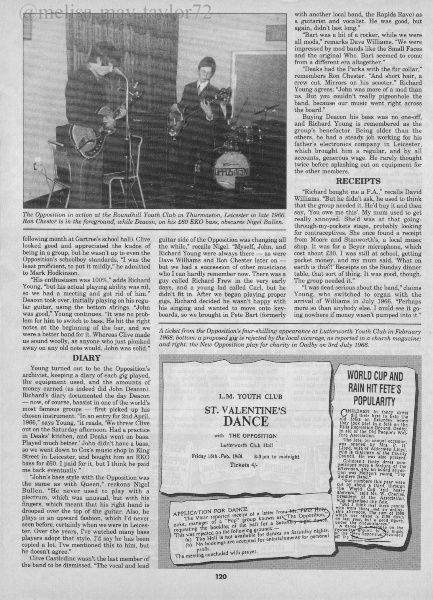
...[ ] following month at Gartree’s school hall). Clive looked good and appreciated the kudos of being in a group, but he wasn’t up to even the Opposition’s schoolboy standards. “I was the least proficient, to put it mildly,” he admitted to Mark Hodkinson.“His enthusiasm was 100%,” adds Richard Young, “but his actual playing ability was null, so we had a meeting and got rid of him.” Deacon took over, initially playing on his regular guitar, using the bottom strings. “John was good,” Young continues. “It was no problem for him to switch to bass. He hit the right notes at the beginning of the bar, and we were a better band for it. Whereas Clive made us sound woolly, as anyone who just plonked away on any old note would, John was solid.”
DIARY
Young turned out to be the Opposition’s archivist, keeping a diary of each gig played, the equipment used, and the amounts of money earned (as indeed did John Deacon). Richard’s diary documented the day Deacon — now, of course, bassist in one of the world’s most famous groups — first picked up his chosen instrument. “In an entry for 2nd April, 1966,” says Young, “it reads, ‘We threw Clive out on the Saturday afternoon. Had a practice in Deaks’ kitchen, and Deaks went on bass. Played much better.’ John didn’t have a bass, so we went down to Cox’s music shop in King Street in Leicester, and bought him an EKO bass for £60. I paid for it, but I think he paid me back eventually.”
“John’s bass style with the Opposition was the same as with Queen,” reckons Nigel Bullen. “He never used to play with a plectrum, which was unusual, but with his fingers, which meant that his right hand is drooped over the top of the guitar. Also, he plays in an upward fashion, which I’d never seen before, certainly when we were in Leicester. Over the years, I’ve watched many bass players adopt that style. I’d say he has been copied a lot. I’ve mentioned this to him, but he doesn’t agree.”
Clive Castledine wasn’t the last member of the band to be dismissed. “The vocal and lead guitar side of the Opposition was changing all the while,” recalls Nigel. “Myself, John, and Richard Young were always there — as were Dave Williams and Ron Chester later on — but we had a succession of other musicians who I can hardly remember now. There was a guy called Richard Frew in the very early days, and a young lad called Carl, but he didn’t fit in. After we began playing proper gigs, Richard decided he wasn’t happy with his singing and wanted to move onto keyboards, so we brought in Pete Bart (formerly with another local band, the Rapids Rave) as a guitarist and vocalist. He was good, but again, didn’t last long.”
“Bart was a bit of a rocker, while we were all mods,” remarks Dave Williams. “We were impressed by mod bands like the Small Faces and the original Who. Bart seemed to come from a different era altogether.”
“Deaks had the Parka with the fur collar,” remembers Ron Chester. “And short hair, a crew cut. Mirrors on his scooter.” Richard Young agrees: “John was more of a mod than us. But you couldn’t really pigeonhole the band, because our music went right across the board”.
”Buying Deacon his bass was no one-off, and Richard Young is remembered as the group’s benefactor. Being older than the others, he had a steady job working for his father’s electronics company in Leicester, which brought him a regular, and by all accounts, generous wage. He rarely thought twice before splashing out on equipment for the other members.
RECEIPTS
“Richard bought me a P.A.,” recalls David Williams. “But he didn’t ask, he used to think that the group needed it. He’d buy it and then say, ‘You owe me this’. My mum used to get really annoyed. She’d was at that going- through-my-pockets stage, probably looking for contraceptives. She once found a receipt from Moore and Stanworth’s, a local music shop. It was for a Beyer microphone, which cost about £30. I was still at school, getting pocket money, and my mum said, ‘What on earth is this?!’ Receipts on the Sunday dinner table, that sort of thing. It was good, though. The group needed it.”
“I was dead serious about the band,” claims Young, who switched to organ with the arrival of Williams in July 1966. “Perhaps more so than anybody else. I could see it going nowhere if money wasn’t pumped into it.”
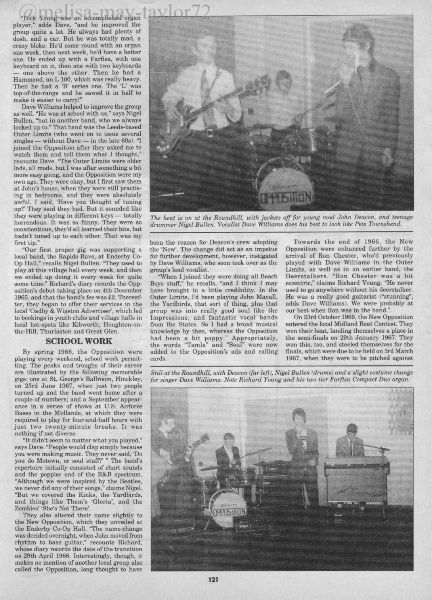
“Dick Young was an accomplished organ player,” adds Dave, “and he improved the group quite a lot. He always had plenty of dosh, and a car. But he was totally mad, a crazy bloke. He’d come round with an organ one week, then next week, he’d have a better one. He ended up with a Farfisa, with one keyboard on it, then one with two keyboards — one above the other. Then he had a Hammond, an L 100. which was really heavy. Then he had a ‘B’ series one. The ‘L’ was top-of-the-range and he sawed it in half to make it easier to carry!”
Dave Williams helped to improve the group as well. “He was at school with us,” says Nigel Bullen, “but in another band, who we always looked up to.” That band was the Leeds-based Outer Limits (who went on to issue several singles — without Dave — in the late ‘60s). “I joined the Opposition after they asked me to watch them and tell them what I thought,” recounts Dave. “The Outer Limits were older lads, all mods, but I was after something a bit more easy going, and the Opposition were my own age. They were okay, but I first saw them at John’s house, when they were still practising in bedrooms, and they were absolutely awful. I said, ‘Have you thought of tuning up?’ They said they had. But it sounded like they were playing in different keys — totally horrendous. It was so funny. They were so conscientious, they’d all learned their bits, but hadn't tuned up to each other. That was my first tip.”
“Our first proper gig was supporting a local band, the Rapids Rave, at Enderby Coop Hall,” recalls Nigel Bullen. “They used to play at this village hall every week. and then we ended up doing it every week for quite some time.” Richard’s diary records the Opposition’s debut taking place on 4th December 1965, and that the band’s fee was £2. Thereafter, they began to offer their Services in the local ‘Oadby & Wigston Advertiser’, which led to bookings in youth clubs and village halls in local hot-spots like Kibworth, Houghton-on- the-Hill, Thurlaston and Great Glen.
SCHOOL WORK
By spring 1966, the Opposition were playing every weekend, school work permitting. The peaks and troughs of their career are illustrated by the following memorable gigs: one at St. George’s Ballroom, Hinckley, on 23rd June 1967, when just two people turned up and the band went home after a couple of numbers; and a September appearance in a series of shows at U.S. Airforce Bases in the Midlands, at which they were required to play for four-and-half hours with just two twenty-minute breaks. It was nothing if not diverse.
“It didn’t seem to matter what you played,” says Dave. “People would clap simply because you were making music. They never said, ‘Do you do Motown, or soul stuff?’ ” The band’s repertoire initially consisted of chart sounds and the poppier end of the R&B spectrum. “Although we were inspired by the Beatles, we never did any of their songs,” claims Nigel. “But we covered the Kinks, the Yardbirds, and things like Them’s ‘Gloria’, and the Zombies’ ‘She’s Not There’.
They also altered their name slightly to the New Opposition, which they unveiled at the Enderby Coop Hall. “The name-change was decided overnight, when John moved from rhythm to bass guitar,” recounts Richard, whose diary records the date of the transition as 29th April 1966. Interestingly, though, it makes no mention of another local group also called the Opposition, long thought to have been the reason for Deacon’s crew adopting the ‘New’. The change did act as an impetus for further development, however, instigated by Dave Williams, who soon took over as the group’s lead vocalist.
“When I joined they were doing all Beach Boys stuff,” he recalls, “and I think I may have brought in a little credibility. In the Outer Limits, I’d been playing John Mayall, the Yardbirds, that sort of thing, plus that group was into really good soul like the Impressions, and fantastic vocal bands from the States. So I had a broad musical knowledge by then, whereas the Opposition had been a bit poppy.” Appropriately, the words “Tamla” and “Soul” were now added to the Opposition’s ads and calling cards.
Towards the end of 1966, the New Opposition were enhanced further by the arrival of Ron Chester, who’d previously played with Dave Williams in the Outer Limits, as well as in an earlier band, the Deerstalkers. “Ron Chester was a bit eccentric,” claims Richard Young. “He never used to go anywhere without his deerstalker. He was a really good guitarist (“stunning”, adds Dave Williams). We were probably at our best when Ron was in the band.”
On 23rd October 1966, the New Opposition entered the local Midland Beat Contest. They won their heat, landing themselves a place in the semifinals on 29th January 1967. They won this, too, and steeled themselves for the finals, which were due to be held on 3rd March 1967, when they were to be pitched against...[ ]
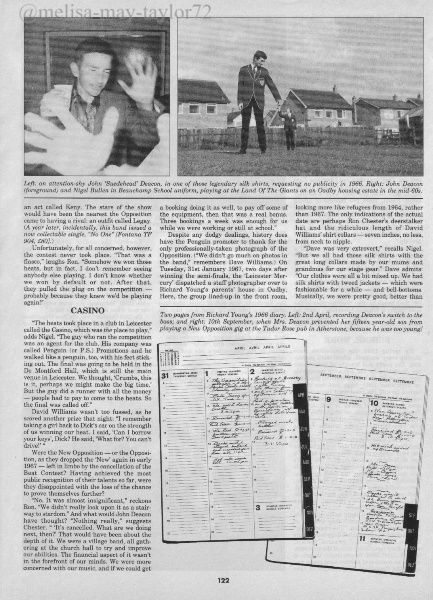
...[ ] an act called Keny. The stars of the show would have been the nearest the Opposition came to having a rival: an outfit called Legay. (A year later, incidentally, this band issued a now collectable single, “No One” (Fontana TF 904,£80J.) Unfortunately, for all concerned, however, the contest never took place. “That was a fiasco,'' laughs Ron. “Somehow we won those heats, but in fact, I don’t remember seeing anybody else playing. I don’t know whether we won by default or not. After that, they pulled the plug on the competition — probably because they knew we’d be playing again!”.
CASINO
“The heats took place in a club in Leicester called the Casino, which was the place to play,” adds Nigel. “The guy who ran the competition was an agent for the club. His company was called Penguin (or P.S) Promotions and he walked like a penguin too, with his feet sticking out. The final was going to be held in the De Montford Hall, which is still the main venue in Leicester. We thought, ‘Crumbs, this is it, perhaps we might make the big time.’ But the guy did a runner with all the money — people had to pay to come to the heats. So the final was called off.”
David Williams wasn’t too fussed, as he scored another prize that night: “I remember taking a girl back to Dick’s car on the strength of us winning our heat. I said, ‘Can I borrow your keys, Dick? He said, ‘What for? You can’t drive!’ “
Were the New Opposition — or the Opposition, as they dropped the ‘New’ again in early 1967 — left in limbo by the cancellation of the Beat Contest? Having achieved the most public recognition of their talents so far, were they disappointed with the loss of the chance to prove themselves further?
“No. It was almost insignificant,” reckons Ron. “We didn’t really look upon it as a stairway to stardom.” And what would John Deacon have thought? “Nothing really,” suggests Chester. “ ‘It’s cancelled. What are we doing next, then?’ That would have been about the depth of it. We were a village band, all gathering at the church hall to try and improve our abilities. The financial aspect of it wasn’t in the forefront of our minds. We were more concerned with our music, and if we could get a booking doing it as well, to pay off some of the equipment, then that was a real bonus. Three bookings a week was enough for us while we were working or still at school.” Despite any dodgy dealings, history does have the Penguin promoter to thank for the only professionally-taken photograph of the Opposition. (“We didn’t go much on photos in the band,” remembers Dave Williams.) On Tuesday, 31st January 1967, two days after winning the semi-finals, the ‘Leicester Mercury’ dispatched a staff photographer over to Richard Young’s parents’ house in Oadby. Here, the group lined-up in the front room, looking more like refugees from 1964, rather than 1967. The only indications of the actual date are perhaps Ron Chester’s deerstalker hat and the ridiculous length of David Williams’ shirt collars — seven inches, no less, from neck to nipple.
“Dave was very extrovert,” recalls Nigel. “But we all had those silk shirts with the great long collars made by our mums and grandmas for our stage gear.” Dave admits: “Our clothes were all a bit mixed up. We had silk shirts with tweed jackets — which were fashionable for a while — and bell-bottoms. Musically, we were pretty good, better than...[ ]
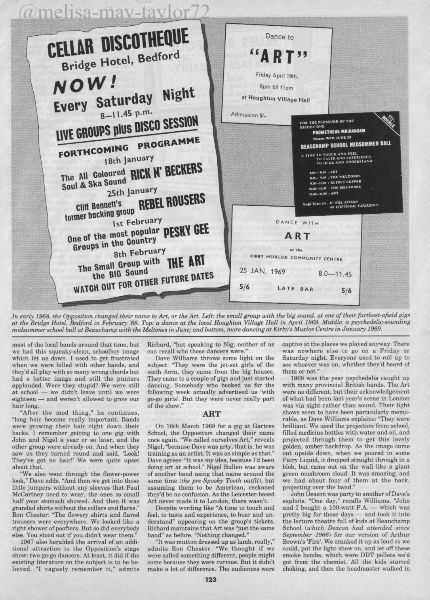
...[ ] most of the local bands around that time, but we had this squeaky-clean, schoolboy image which let us down. I used to get frustrated when we were billed with other bands, and they’d all play with so many wrong chords but had a better image and still the punters applauded. Were they stupid? We were still at school — we didn’t leave until we were eighteen — and weren’t allowed to grow our hair long”.
“After the mod thing,” he continues, “long hair became really important. Bands were growing their hair right down their backs. I remember getting to one gig with John and Nigel a year or so later, and the other group were already on. And when they saw us they turned round and said, ‘Look! They’ve got no hair!’. We were quite upset about that”.
“We also went through the flower-power look,” Dave adds. “And then we got into those little jumpers without any sleeves that Paul McCartney used to wear, the ones so small that half your stomach showed. And then it was grandad shirts without the collars and flares.” Ron Chester: “The flowery shirts and flared trousers were everywhere. We looked like a right shower of poofters. But so did everybody else. You stood out if you didn’t wear them.”
1967 also heralded the arrival of an additional attraction to the Opposition’s stage show: two go-go dancers. At least, it did if the existing literature on the subject is to be believed. “I vaguely remember it,” admits Richard, “but speaking to Nig, neither of us can recal who those dancers were”.
Dave Williams throws some light on the subject: “They were the jet-set girls of the sixth form, they came from the big houses. They came to a couple of gigs and just started dancing. Somebody who booked us for the following week actually advertised us ‘with go-go girls’. But they were never really part of the show.”
ART
On 16th March, 1968 for a gig at Gartree School, the Opposition changed their name once again. “We called ourselves Art,” reveals Nigel, “because Dave was arty, that is, he was training as an artist. It was as simple as that.” Dave agrees: “It was my idea, because I’d been doing art at school.” Nigel Bullen was aware of another band using that name around the same time (the pre-Spooky Tooth outfit), but assuming them to be American, reckoned they’d be no confusion. As the Leicester-based Art never made it to London, there wasn’t.
Despite wording like “A time to touch and feel, to taste and experience, to hear and understand” appearing on the group’s tickets, Richard maintains that Art was “just the same band” as before. “Nothing changed."
“It was mutton dressed up as lamb, really,” admits Ron Chester. “We thought if we were called something different, people might come because they were curious. But it didn’t make a lot of difference. The audiences were captive at the places we played anyway. There was nowhere else to go on a Friday or Saturday night. Everyone used to roll up to see whoever was on, whether they’d heard of them or not.”
1968 was the year psychedelia caught up with many provincial British bands. The Art were no different, but their acknowledgement of what had been last year’s scene in London was via sight rather than sound. Their light shows seem to have been particularly memorable, as Dave Williams explains: “They were brilliant. We used the projectors from school, filled medicine bottles with water and oil, and projected through them to get this lovely golden, amber backdrop. As the image came out upside down, when we poured in some Fairy Liquid, it dropped straight through in a blob, but came out on the wall like a giant green mushroom cloud. It was amazing, and we had about four of them at the back, projecting over the band.”
John Deacon was party to another of Dave’s exploits. “One day,” recalls Williams, “John and I bought a 100-watt P.A. — which was pretty big for those days — and took it into the lecture theatre full of kids at Beauchamp School (which Deacon had attended since September 1966) for our version of Arthur Brown’s ‘Fire’. We cranked it up as loud as we could, put the light show on, and let off these smoke bombs, which were DDT pellets we’d got from the chemist. All the kids started choking, and then the headmaster walked in...[ ]
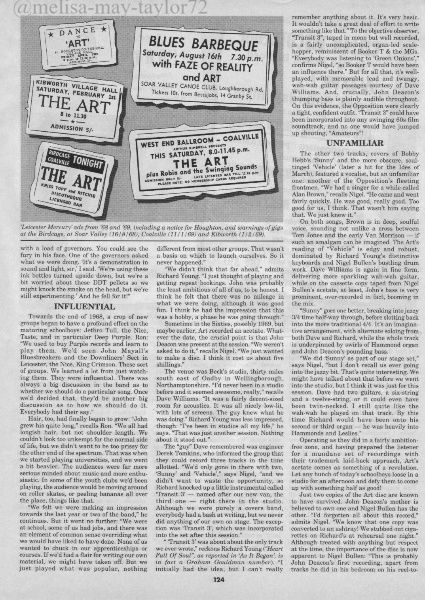
...[ ] with a load of governors. You could see the fury in his face. One of the governors asked what we were doing. ‘It’s a demonstration in sound and light, sir,’ I said. ‘We’re using these ink bottles turned upside down, but we’re a bit worried about these DDT pellets so we might knock the smoke on the head, but we’re still experimenting.’ And he fell for it!”.
INFLUENTIAL
Towards the end of 1968, a crop of new groups began to have a profound effect on the maturing schoolboys: Jethro Tull, the Nice, Taste, and in particular Deep Purple. Ron: “We used to buy Purple records and learn to play them. We’d seen John Mayall’s Bluesbreakers and the Downliners’ Sect in Leicester, the Nice, King Crimson. These sort of groups. We learned a lot from just watching them. They were influential. There was always a big discussion in the band as to whether we should do a particular song. Once we’d decided that, there’d be another big discussion as to how we should do it. Everybody had their say.”
Hair, too, had finally began to grow: “John grew his quite long,” recalls Ron. “We all had longish hair, but not shoulder length. We couldn’t look too unkempt for the normal side of life, but we didn’t want to be too prissy for the other end of the spectrum. That was when we started playing universities, and we went a bit heavier. The audiences were far more serious minded about music and more enthusiastic. In some of the youth clubs we’d been playing, the audience would be moving around on roller skates, or peeling bananas all over the place, things like that”.
“We felt we were making an impression towards the last year or two of the band,” he continues. But it went no further: “We were at school, some of us had jobs, and there was an element of common sense overriding what we would have liked to have done. None of us wanted to chuck in our apprenticeships or courses. If we’d had a flair for writing our own material, we might have taken off. But we just played what was popular, nothing different from most other groups. That wasn’t a basis on which to launch ourselves. So it never happened."
“We didn’t think that far ahead,” admits Richard Young. “I just thought of playing and getting repeat bookings. John was probably the least ambitious of all of us, to be honest. I think he felt that there was no mileage in what we were doing, although it was good fun. I think he had the impression that this was a hobby, a phase he was going through.”
Sometime in the Sixties, possibly 1969, but maybe earlier, Art recorded an acetate. Whatever the date, the crucial point is that John Deacon was present at the session. “We weren't asked to do it,” recalls Nigel. “We just wanted to make a disc. I think it cost us about five shillings.”
The venue was Beck’s studio, thirty miles south east of Oadby in Wellingborough, Northamptonshire. “I’d never been in a studio before and it seemed awesome, really,” recalls Dave Williams. “It was a fairly decent-sized room for acoustics. It was all nicely low-lit, with lots of screens. The guy knew what he was doing.” Richard Young was less impressed, though: I’ve been in studios all my life,” he says. “That was just another session. Nothing about it stood out.”
The “guy” Dave remembered was engineer Derek Tomkins, who informed the group that they could record three tracks in the time allotted. “We’d only gone in there with two, ‘Sunny’ and ‘Vehicle’,” says Nigel, “and we didn’t want to waste the opportunity, so Richard knocked up a little instrumental called Transit 3’ — named after our new van, the third one — right there in the studio. Although we were purely a covers band, everybody had a bash at writing, but we never did anything of our own on stage. The exception was Transit 3’, which was incorporated into the set after this session.”
“ Transit 3’ was about about the only track we ever wrote," reckons Richard Young (“Heart Full Of Soul”, as reported in ‘As It Began’, is in fact a Graham Gouldman nurnber). “I initially had the idea, but I can’t really remember anything about it. It’s very basic. It wouldn’t take a great deal of effort to write something like that.” To the objective observer, “Transit 3”, taped in mono but well recorded, is a fairly uncomplicated, organ-led scale- hopper, reminiscent of Booker T & the MGs.
“Everybody was listening to ‘Green Onions’,” confirms Nigel, “so Booker T would have been an influence there.” But for all that, it’s well- played, with memorable lead and twangy, wah-wah guitar passages courtesy of Dave Williams. And, crucially, John Deacon’s thumping bass is plainly audible throughout. On this evidence, the Opposition were clearly a tight, confident outfit. “Transit 3” could have been incorporated into any swinging ‘60s film soundtrack, and no one would have jumped up shouting, “Amateurs”!.
UNFAMILIAR
The other two tracks, covers of Bobby Hebb’s ‘Sunny' and the more obscure, soul- tinged ‘Vehicle’ (later a hit for the Ides of March), featured a vocalist, but an unfamiliar one: another of the Opposition’s fleeting frontmen. “We had a singer for a while called Alan Brown,” recalls Nigel. “He came and went fairly quickly. He was good, really good. Too good for us, I think. That wasn’t him saying that. We just knew it.”
On both songs, Brown is in deep, soulful voice, sounding not unlike a cross between Tom Jones and the early Van Morrison — if such an amalgam can be imagined. The Art’s reading of “Vehicle” is edgy and robust, dominated by Richard Young’s distinctive keyboards and Nigel Bullen’s bustling drum work. Dave Williams is again in fine form, delivering more sparkling wah-wah guitar, while on the cassette copy taped from Nigel Bullen’s acetate, at least, John’s bass is very prominent, over-recorded in fact, booming in the mix.
“Sunny” goes one better, breaking into jazzy 3/4 time halfway through, before slotting back into the more traditional 4/4. It’s an imaginative arrangement, with alternate soloing from both Dave and Richard, while the whole track is underpinned by swirls of Hammond organ and John Deacon’s pounding bass.
“We did ‘Sunny’ as part of our stage set,” says Nigel, “but I don’t recall us ever going into the jazzy bit. That’s quite interesting. We might have talked about that before we went into the studio, but I think it was just for this session. Dave had two guitars, a six-string and a twelve-string, or it could even have been twin-necked. I still quite like the wah-wah he played on that track. By this time Richard would have been onto his second or third organ — he was heavily into Hammonds and Leslies."
Operating as they did in a fairly ambition- free zone, and having prepared the listener for a mundane set of recordings with their trademark laid-back approach, Art’s acetate comes as something of a revelation. Let any bunch of today’s schoolboys loose in a studio for an afternoon and defy them to come up with something half as good!
Just two copies of the Art disc are known to have survived. John Deacon’s mother is believed to own one and Nigel Bullen has the other. “I’d forgotten all about this record,” admits Nigel. “We know that one copy was converted to an ashtray!. We stubbed out cigarettes on Richards at rehearsal one night.” Although treated with anything but respect at the time, the importance of the disc is now apparent to Nigel Bullen: “This is probably John Deacon’s first recording, apart from tracks he did in his bedroom on his reel-to-...[ ]
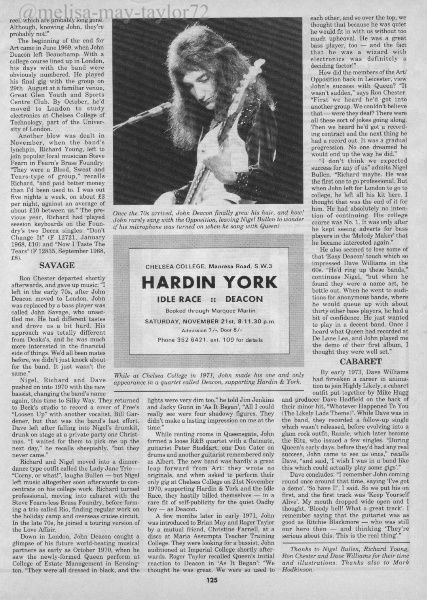
...[ ] reel, which are probably long gone. Although, knowing John, they’re probably not!”
The beginning of the end for Art came in June 1969, when John Deacon left Beauchamp. With a college course lined up in London, his days with the band were obviously numbered. He played his final gig with the group on 29th August at a familiar venue, Great Glen Youth and Sports Centre Club. By October, he’d moved to London to study electronics at Chelsea College of Technology, part of the University of London.
Another blow was dealt in November, when the band's lynchpin, Richard Young, left to join popular local musician Steve Fearn in Fearn’s Brass Foundry.
“They were a Blood, Sweat and Tears-type of group,” recalls Richard, “and paid better money than I’d been used to. I was out five nights a week, on about £3 per night, against an average of about £10 between us.” The previous year, Richard had played session keyboards on the Foundry’s two Decca singles: “Don’t Change It” (F 12721, January 1968, £10) and “Now I Taste The Tears” (F 12835. September 1968, £8).
SAVAGE
Ron Chester departed shortly afterwards, and gave up music: “I left in the early 70s, after John Deacon moved to London. John was replaced by a bass player was called John Savage, who unsettled me. He had different tastes and drove us a bit hard. His approach was totally different from Deaks's, and he was much more interested in the financial side of things. We’d all been mates before, we didn't just knock about for the band. It just wasn’t the same.”
Nigel, Richard and Dave pushed on into 1970 with the new bassist, changing the band’s name again, this time to Silky Way. They returned to Beck’s studio to record a cover of Free’s “Loosen Up” with another vocalist, Bill Gardener, but that was the band’s last effort. Dave left after falling into Nigel’s drumkit, drunk on stage at a private party one Christmas. “I waited for them to pick me up the next day,” he recalls sheepishly, “but they never carne.”
Richard and Nigel moved into a dinner- dance type outfit called the Lady Jane Trio — “Corny, or what!”, laughs Bullen — but Nigel left music altogether soon afterwards to concentrate on his college work. Richard turned professional, moving into cabaret with the Steve Fearn-less Brass Foundry, before forming a trio called Rio, finding regular work on the holiday camp and overseas cruise circuit. In the late ‘70s, he joined a touring version of the Love Affair.
Down in London, John Deacon caught a glimpse of his future world-beating musical partners as early as October 1970, when he saw the newly-formed Queen perform at College of Estate Management in Kensington. “They were all dressed in black, and the lights were very dim too,” he told Jim Jenkins and Jacky Gunn in ‘As It Began’, “All I could really see were four shadowy figures. They didn’t make a lasting impression on me at the time.”
While renting rooms in Queensgate, John formed a loose R&B quartet with a flatmate, guitarist Peter Stoddart, one Don Cater on drums and another guitarist remembered only as Albert. The new band was hardlv a great leap forward from Art: they wrote no originals, and when asked to perform their only gig at Chelsea College on 21st November 1970, supporting Hardin & York and the Idle Race, they hastily billed themselves — in a rare fit of self-publicity for the quiet Oadby boy — as Deacon.
A few months later in early 1971, John was introduced to Brian May and Roger Taylor by a mutual friend, Christine Farnell, at a disco at Maria Assumpta Teacher Training College. They were looking for a bassist. John auditioned at Imperial College shortly afterwards. Roger Taylor recalled Queen’s initial reaction to Deacon in ‘As It Began’: “We thought he was great. We were so used to each other, and so over the top, we thought that because he was quiet he would fit in with us without too much upheaval. He was a great bass player, too — and the fact that he was a wizard with electronics was definitely a deciding factor!”
How did the members of the Art/Opposition back in Leicester, view John’s success with Queen? “It wasn’t sudden”, says Ron Chester. “First we heard he’d got into another group. We couldn’t believe that — were they deaf? There were all these sort of jokes going along. Then we heard he’d got a recording contract and the next thing he had a record out. It was a gradual progression. No one dreamed he would end up the way he did.”
“I don’t think we expected success for any of us" admits Nigel Bullen. “Richard maybe. He was the first one to go professional. But when John left for London to go to college, he left all his kit here. I thought that was the end of it for him. He had absolutely no intention of continuing. His college course was No.1. It was only after he kept seeing adverts for bass players in the ‘Melody Maker’ that he became interested again.”
He also seemed to lose some of that ‘Easy Deacon’ touch which so impressed Dave Williams in the ‘60s. “He’d ring up these bands,” continues Nigel, “but when he found they were a name act, he bottle out. When he went to auditions for anonymous bands, where he would queue up with about thirty other bass players, he had a bit of confidence. He just wanted to play in a decent band. Once I heard what Queen had recorded at De Lane Lea, and John played me the demo of their first album, I thought they were well set.”
CABARET
By early 1973, Dave Williams had forsaken a career in animation to join Highly Likely, a cabaret outfit put together by Mike Hugg and producer Dave Hadfield on the back of their minor hit, “Whatever Happened To You (The Likely Lads Theme)”. While Dave was in the band, they recorded a follow-up single which wasn’t released, before evolving into a glam rock outfit, Razzle, which later become the Ritz, who issued a few singles. “During Queen’s early days, before they’d had any real success, John came to see us once,” recalls Dave, “and said, ‘I wish I was in a band like this which could actually play some gigs’.” Dave concludes: “I remember John coming round once around that time, saying I’ve got a demo’. ‘So have I!’, I said. So we put his on first, and the first track was ‘Keep Yourself Alive’. My mouth dropped wide open and I thought. ‘Bloody hell! What a great track’. I remember saying that the guitarist was as good as Ritchie Blackmore — who was still our hero then — and thinking ‘They’re serious about this. This is the real thing’.”
RECORD COLLECTOR Nº 198 FEBRUARY 1996
⬅PREVIOUS: SMILE
https://melisa-may-taylor72.tumblr.com/post/639672109315014656/queen-before-queen-the-1960s-recordings
➡NEXT: IBEX, WRECKAGE & SOUR MILK SEA
@natromanxoff, @mephisto92, @moviestorian, @x5vale, @39-brian, @onegoldenglance, @crosmopolitan, @an-abyss-called-life, @his-majesty-king-mercury, @i-live-for-queen, @brian-39-may, @toomuchlove-willkillyou, @brimaymay, @sail-away-sweet-sister, @drummerqueenrmt, @old-fashioned-roger-boy, @briianmaay, @inui-mycroft, @deacytits, @iminlovewithrogscar, @drowseoftaylor, @brianmayislongaway, @balticlover, @astrophysicist-guitar-god, @miez-lakatz, @brianmayoucease, @jesus-in-a-life-boat, @aslongasthereismusic, @roger-taylors-car, @silapril, @sherrifanciesfriskyfreddie, @tenderbri, @brianmydear, @thosequeenboys, @millionairewaltz-carpediem, @painandpleasure86, @bribrifrenchfry, @xlucylennonx, @a-night-at-the-abbey-road, @inthedayswhenlandswerefew, @madformeddowstaylor, @queenrogertaylorfan, @let-roger-get-a-lunch, @queen-for-life, @rethought, @drivenbybrianmay @mymakeupmaybeflaking, @old-but-still-a-child, @let-roger-get-a-lunch, @warriorteam1924, @funnydressesweirdhairanddance, @painkiller80, @thefanhuman13, @yourtieddownmother, @hgmercury39, @brimi-stardust, @thefairyfellermercury, @retroromantics, @sailawaysweetbrimi, @sophiaintheskywithdiamonds, @holybrianmaywritingbear, @lydiannode, @39-yellow-daffodils , @ure-gonna-loveme-when-u-seeme, @kaykaybeachgirl, @foxmonkey, @deakysgurl, @redspecialandclogsandcurls, @briansrainbowsocks-deactivated2, @delilahmay39, @ohmybribri, @bless-the-queen, @everythingaboutfreddie, @doitforthevine67, @recordsoftheseventies, @rhysjoejoshtomfarisblog, @tenementfunsterwithpurpleshoes, @drummah-in-a-rocknroll-band, @beatlegirl1968, @maylorsqueen, @autumnscenemcyt, @gralto, @alittlepeoplemagic, @rainbowsockbrian, @frejudy, @drivenbybri, @yourlocalmusicalprostitute, @saik-ava, @omb-xx, @sassymaylor, @somekindofroger, @starlightmay, @freddiemercuryismylife, @sunshine112, @chrysochromulina, @glitteryloveravenue, @deakyislife51, @0-primejive-0, @just-a-skinny-lad, @bluewillowmom, @sassiesillie, @stesichoreanpalinode, @farrokhbulsaramercury, @tayloredofqueen, @rushingheadlong, @izzy-is-slightly-mad, @scandalacious, @0-my-fairy-queen-0 @39-volunteers-to-space@zodiacaldust, @deakytaylor, @queenband70s, @deakyeveryday, @drivenbybrimay @70smay
201 notes
·
View notes
Text
(2021/04/16) CIA Assassination Plot Targeted Cuba's Raul Castro
[nsarchive.gwu.edu][1]
[1]: <https://nsarchive.gwu.edu/briefing-book/cuba/2021-04-16/documents-cia-assassination-plot-targeted-raul-castro>
# CIA Assassination Plot Targeted Cuba's Raul Castro
10-13 minutes
* * *
As Castro Retires on 60th Anniversary of the Bay of Pigs, National Security Archive Posts Declassified Top Secret CIA Cables, Reports from 1960
Agency Officials Willing to Pay Over $10,000 For ‘Fatal Accident’
Another Assassination Plot against Fidel Castro Was Part of Bay of Pigs Invasion Strategy
**Washington D.C., April 16, 2021 –** In the earliest known CIA assassination plot against leaders of the Cuban revolution, high agency officials offered the pilot of a plane carrying Raul Castro from Prague to Havana “payment after successful completion of ten thousand dollars” to “incur risks in arranging accident” during the flight, according to formally TOP SECRET documents posted today by the National Security Archive. The pilot, who the CIA had earlier recruited as an intelligence asset in Cuba, “asked for assurance that in event of his [own] death the U.S. would see that his two sons were given a college education.” “This assurance was given,” his CIA handler in Havana, William J. Murray, reported.
According to TOP SECRET cables between the CIA headquarters and the CIA Havana station, and debriefings Murray later provided on "questionable activities," the plot quickly evolved after the Cuban pilot, Jose Raul Martinez, advised Murray that he had been selected to fly a chartered Cubana Airlines plane to Prague to pick up Raul Castro and other high-ranking Cuban leaders on July 21, 1960. When Murray informed his superiors at Langley headquarters, as he later told the Rockefeller Commission on the CIA, “headquarters cabled back that it was considering the possibility of a fatal accident and asked whether the pilot would be interested.”
The cable, classified “TOP SECRET RYBAT OPERATIONAL IMMEDIATE” and signed by CIA Deputy Director of Plans Tracy Barnes, and J.C. King, the head of the CIA’s Western Hemisphere Division, informed Murray that “possible removal of top three leaders is receiving serious consideration at HQS” and asked if the pilot had “motivation sufficient to incur risks of arranging accident during return trip” from Prague. To provide sufficient motivation, Barnes and King offered $10,000, or “a reasonable demand in excess of that” as well as to arrange rescue facilities for the pilot after the “accident” took place.
Murray discussed the proposal with Martinez in a car as the pilot drove to the Havana airport to fly to Prague. “Subj willing to take calculated risk but limited to foll[owing] possibilities which can pass as accidental: A. engine burnout on take off to delay or harass trip. B. Vague possibility water ditching approx. 3 hours out from Cuba,” Murray reported to Langley after the meeting. “Subj rules out engine failure in flight due [to] imminent danger [of] fire and lack of opportunity to save any passengers or crew … Doubts ability perform real accident without endangering lives of all on board.”
After Martinez left for Prague, the Havana station received a second cable, signed by Tracy Barnes, that rescinded the assassination plot. “Do not pursue,” it stated. “Would like to drop matter.” By then, however, there was no way to reach the pilot. When he returned, Martinez reported to Murray that “he had no opportunity to arrange an accident such as we had discussed.”
This “accident plot” was obliquely described in the special Senate Committee report on _Alleged Assassination Plots Involving Foreign Leaders_ , published 1976 after an investigation into CIA covert actions led by Senator Frank Church. The Church Committee report identified the plot as “the first action against the life of a Cuban leader sponsored by the CIA of which the Committee is aware” but withheld—or perhaps was denied—key details, including that the would-be assassin was a pilot and the “accident” would involve a civilian airliner. Nor did the Committee publish any of the documents on which its description was based.
The TOP SECRET documents were later declassified as part of the JFK Assassination Records Act and obtained by National Security Archive senior analyst John Prados for the Archive’s digital collection, _CIA Covert Operations II: The Year of Intelligence, 1975._
### The Bay of Pigs Assassination Plot
The Bay of Pigs operation also involved a complex CIA plot to assassinate Fidel Castro, launched only a few weeks after the short-lived effort to kill his brother. In August 1960, the CIA’s director of covert operations, Richard Bissell, authorized what one SECRET EYES ONLY CIA memo described as “a sensitive mission requiring gangster-type action.” The mission “was the liquidation of Fidel Castro.” As the top CIA official in charge of the Bay of Pigs operation, Bissell’s intention was to assassinate Castro and enhance the chances of success for CIA’s counterrevolutionary program to overthrow his regime.
In a filmed interview Kornbluh conducted with Jacob Esterline, the CIA manager of the paramilitary invasion, Esterline said that he had been asked to divert over $150,000 from his budget for unspecified reasons but had refused to do so until he was briefed by Bissel’s chief of security, Sheffield Edwards. After he learned the funds were designated to pay the mafia to arrange Castro’s assassination—using poisoned pills created by the agency’s Technical Services Division—Esterline protested to the head of the Western Hemisphere Division, J.C. King. “I said, ‘J.C. do you realize that this is going to make people take this whole thing less seriously if somebody thinks there’s an easy way out with Castro being killed?’”
“I thought it was absolutely amoral that we involve ourselves for the record in anything of this sort,” Esterline told Kornbluh. “Number one, I was just having trouble coming to grips with that. But number two, I thought it would also be the most self-defeating thing for the operation which was going to be [difficult] at best.” (Peter Kornbluh, [_Bay of Pigs Declassified_][2], pp. 264, 265)
[2]: <https://www.amazon.com/Bay-Pigs-Declassified-Invasion-Documents/dp/1565844947>
The Archive is publishing these records as the Castro era in Cuba comes to a formal end. As the Cuban Communist Party convenes its 8th party congress on the 60th anniversary of the Bay of Pigs invasion, Raul Castro is stepping down from his powerful position as party leader. “Just as the defeat of the CIA-led invaders at the Bay of Pigs marked a historic turning point for the young revolution,” according to Peter Kornbluh who directs the Archive’s Cuba project, “the official beginning of the post- Castro era marks a major turning point for Cuba’s future.”
## READ THE DOCUMENTS
[![document thumbnail][3]][4]
[3]: https://assets.documentcloud.org/documents/20616617/pages/1-p1-thumbnail.gif [4]: <https://nsarchive.gwu.edu/dc.html?doc=20616617-1>
1975-01-17
After the scandal about CIA efforts to assassinate foreign leaders such as Fidel Castro breaks in the media in early 1975, a former agent in the Havana station, William J. Murray, files a report to the agency’s inspector general on the earliest known plot in Cuba to kill a leader of the revolution—Raul Castro. Murray recounts how one of his recruited Cuban intelligence assets, a pilot, informed him on July 18, 1960, that he had been assigned to fly to Prague to pick up Raul Castro and other Cuban officials. After he informed CIA headquarters, Murray received an urgent, highly classified cable instructing him to offer the pilot $10,000 or more to motivate him to “cooperate in arranging an accident during the return trip from Prague.” The pilot agreed to “take a calculated risk but limited the possibilities which could pass as an accident.” In the end, no attempt was undertaken, and CIA officials rescinded the assassination instructions.
[![document thumbnail][5]][6]
[5]: https://assets.documentcloud.org/documents/20616618/pages/2-p1-thumbnail.gif [6]: <https://nsarchive.gwu.edu/dc.html?doc=20616618-2>
1960-07-21
Top officials in the CIA’s covert operations division sent this urgent telegram to their agent in Havana, William Murray, instructing him to encourage a pilot who is going to be flying Raul Castro from Prague to Havana “to incur risks in arranging accident during return trip.” The CIA would offer $10,000 and meet “a reasonable demand in excess of that” once the accident had been completed. The cable begins by stating that “possible removal top three leaders is receiving serious consideration at HQS.”
[![document thumbnail][7]][8]
[7]: https://assets.documentcloud.org/documents/20616619/pages/3-p1-thumbnail.gif [8]: <https://nsarchive.gwu.edu/dc.html?doc=20616619-3>
1960-07-22
After conferring with the pilot just before he leaves for Prague, Murray reports back that “subj willing to take calculated risk” but limited to “possibilities which can pass as accidental.” The two discussed puncturing the tire of the plane to cause an accident, and even a real crash of some sort by causing engine failure which the pilot rules out because of “lack of opportunity to save any passengers or crew.” Among the options the pilot will consider is “vague possibility water ditching approx. 3 hours out from Cuba.”
[![document thumbnail][9]][10]
[9]: https://assets.documentcloud.org/documents/20616614/pages/4-p1-thumbnail.gif [10]: <https://nsarchive.gwu.edu/dc.html?doc=20616614-4>
1960-07-21
After the pilot has left for Prague, CIA headquarters sends a second, short, two-sentence cable shutting down the operation. “Do not pursue ref[erence cable],” it states. “Would like to drop matter.” The cable arrives too late to alert the pilot that the CIA no longer wants to advance the assassination plot.
[![document thumbnail][11]][12]
[11]: https://assets.documentcloud.org/documents/20616615/pages/5-p1-thumbnail.gif [12]: <https://nsarchive.gwu.edu/dc.html?doc=20616615-5>
1975-06-11
The official Rockefeller Commission appointed by President Gerald Ford to investigate CIA misconduct, debriefs William Murray on the 1960 plot against Raul Castro, as well as a more general discussion of the CIA’s role in encouraging efforts to overthrow Castro in the early 1960s. The memcon of the meeting records Murray as pointing out that “in many Latin American countries assassination is historically not an unusual form of changing government.”
[![document thumbnail][13]][14]
[13]: https://assets.documentcloud.org/documents/20616616/pages/6-p1-thumbnail.gif [14]: <https://nsarchive.gwu.edu/dc.html?doc=20616616-6>
1966-06-24
The CIA’s director of security, Howard J. Osborn, sends a detailed summary to the deputy director on the CIA-Mafia collaboration to assassinate Castro before the Bay of Pigs invasion. The history starts with the authorization from the deputy director for plans, Richard Bissell, for “a sensitive mission requiring gangster-type action. The mission target was the liquidation of Fidel Castro.” The report describes how Robert Maheu was used as a CIA “cutout” to approach mobsters Johnny Roselli and Sam Gold. It also describes how the CIA’s Technical Services Division “developed a pill that had the elements of rapid solubility, high lethal content, and little or no traceability” as an assassination device. Six pills were produced and passed initially to a Cuban official with mafia ties, Juan Orta. When he got “cold feet,” the pills were passed to a member of the Cuba Exile Junta, Anthony Verona, to pass to operatives in Havana. But, the report states, “Verona’s potential was never fully exploited as the project was cancelled shortly after the Bay of Pigs episode.”
4 notes
·
View notes
Text
Poplar Forest & Bedford
When we first arrived at Poplar Forest that lies on the outskirts of Lynchburg in Bedford County, we were blown away by the beautiful landscape that surrounded Thomas Jefferson’s retreat. Our team had heard such good things about the historic site from those who work there, our professors, and fellow students, we knew it was a must see spot. When we walked into the visitors center, we were greeted by the most kind staff member that we have encountered at any historic site. He was helpful, sweet, and even asked us about our research. We felt very welcome as soon as we walked through the door. To begin the tour, we started with a fifteen minute video introduction to Poplar Forest. Before the tour began, we realized our tour guide seemed to have little enthusiasm when one man asked her if she was our tour guide and she responded with a flat “yes.” After that odd encounter, we watched the wonderfully done film on Jefferson’s retreat home. The short video captured the stories of Jefferson, the enslaved people who worked there, and the importance of the architecture of the site. We were all looking forward to the tour of the historic home and the rest of our day at Poplar Forest after this.
We began the tour outside of the octagonal mansion with our tour guide explaining the symmetric architecture that Jefferson wanted to experiment with. By combining all of the techniques he had seen in Europe, he created this small, yet grand mansion as his getaway. But, he is not the one who put the physical labor into creating this architectural masterpiece. The enslaved people of Poplar Forest are the real champions of constructing the illustrious home. Our tour guide made that clear when she described much of the back-breaking work the enslaved people, like John Hemings, put into the building. She pointed out the only asymmetric detail, the wing of the home, where the enslaved people spent most of their days cooking, cleaning, and keeping the home the way Jefferson wanted. Unlike other Jefferson designs, there was no other wing to complete the symmetry. As Travis McDonald would explain to us later, “the second wing is the million dollar question.” Speculation from staff who have greatly studied the wing says it was just unnecessary to add another space to the home. We walked a little further to see the newly reconstructed carriage turnaround to what it would have looked like in Jefferson’s day. At Poplar Forest, the staff has taken huge steps to ensure the complete correctness of their rebuilding of the home. Our tour guide made sure we knew this once we entered the home. We were all impressed by the moulding, exact replicas, and specificity of the measurements for the rooms. Not only is the representation of the home wonderfully done, but the interpretation was wonderful. Though our tour guide was a bit quiet and unenthused, she did not refrain from allowing Jefferson to be talked about as human and did not glorify him. She was able to express his architectural genius all the while letting us know he did not build one piece of it. He was wholly dependent on enslaved laborers to have his elitist lifestyle. It was encouraging to see a second site where Jefferson was able to be learned about earnestly and not in a God-like manner. Our tour guide also explained to us in the parlor room how he had a more familial side with his granddaughters who frequently accompanied him at Poplar Forest. In the last room, we got to see the room that mirrored Jefferson's bedroom. While his room was fully restored, this room was used as a progress room to show how the staff at Poplar Forest worked to recreate the Jeffersonian home after it had undergone fire and renovations from other residents. Also in this room was an original John Hemings door. This was a site to see as we all know that he was responsible for most of the ornate mouldings and doors in the original home. We all enjoyed the house tour and were incredibly impressed with all the work the staff at Poplar Forest has done in the short 40 years they have been a museum. In the grand scheme of things, 40 years and starting from scratch is not long for the project that they had ahead of them.
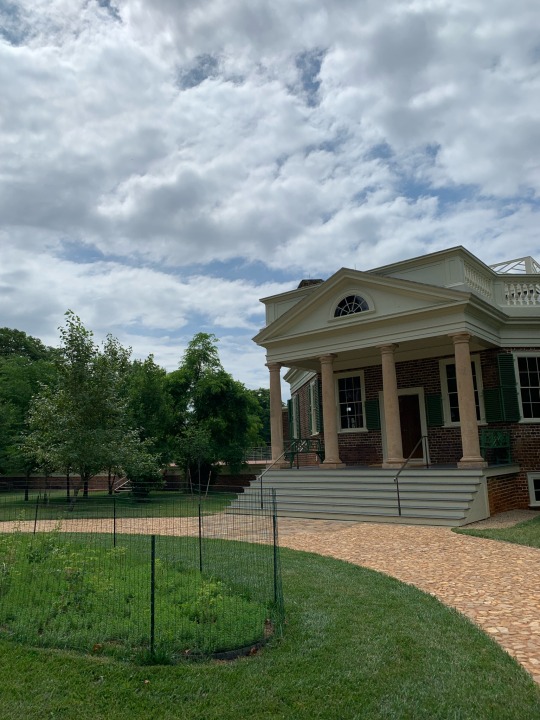
In the basement and the wing of the mansion is an exhibit dedicated to the enslaved workers of Poplar Forest. This was not a part of the house tour, but we made sure to see all that was displayed on our own. We saw the familiar name of John Hemings featured throughout. Without his tireless efforts, the home would not have been able to feature such unique architectural details. Though Thomas Jefferson was a master architect, he was never doing the hard work of actually building what he designed throughout his life. It was enlightening to see what archaeological finds have been discovered at the site. There was one display case that featured a series of items collected by rats in the attic of the home between 1846 and the 1960s, which was far beyond Thomas Jefferson’s ownership of the property. There were fragments of book pages, newspapers, clothes, and more. We walked over to see what was displayed in the wing between the east side of the home and the east mound, and we were amazed to find the kitchen with fireplaces, hearths, and a cook’s quarters. On display in one of the rooms was a letter from Hannah, an enslaved woman, written to Thomas Jefferson. In the letter, she expresses sadness about his inability to visit Poplar Forest that Fall and she also paraphrased the Bible - “we ought to serve and obey his commandments that you may set to win the prize and after glory run.” We believe this letter clearly shows a level of hopelessness and despair within Hannah, but it also depicts a unique dynamic of an enslaved person being allowed the ability to write. This must have been a unique circumstance. We are extremely pleased with the archaeological excavations done to bring the Wing of Offices back to their original form. Past the East mound are structures of the era beyond Thomas Jefferson’s ownership of the property and contained the living quarters of enslaved people during the antebellum era up through emancipation. There was a small exhibit in one of the spaces that allowed further learning about the enslaved. Down the hill and near a modern residential community is a reconstructed enslaved person quarters known as the North Hill site. It was built with logs and had a chimney lined with clay to avoid the spread of fires. A small garden likely existed since food rations were so limited. It was amazing to see the basic shape and size of what the enslaved lived within and is a stark contrast to the extravagance of the mansion. Reconstructing such structures allow sites like Poplar Forest to share the hard, yet necessary, truths of what enslavement looked like.
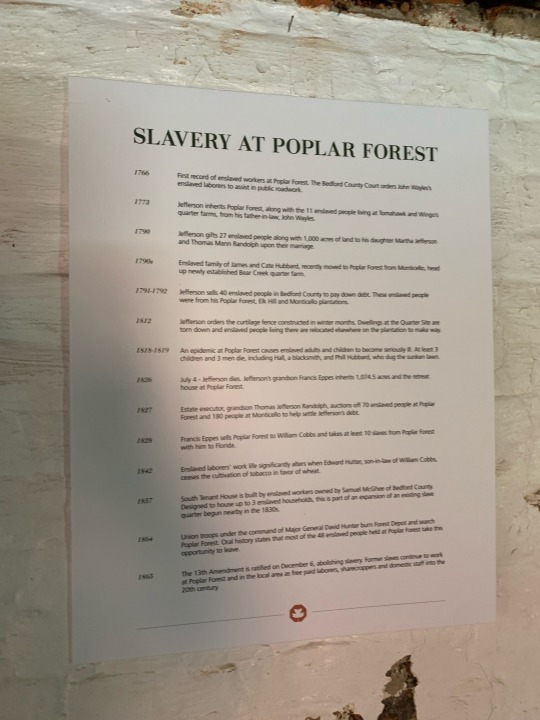

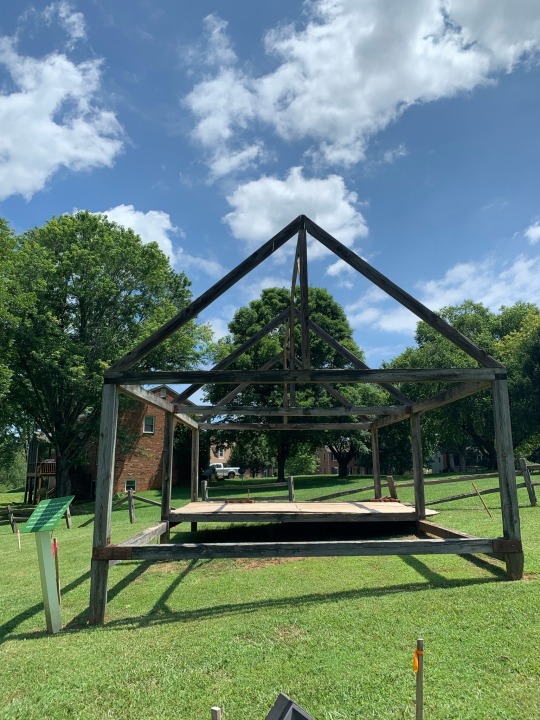

Our last stop after the gift shop at Poplar Forest was to Travis McDonald’s office. McDonald is the Director of Architectural Restoration at Poplar Forest. He has been with the foundation from the very beginning. His skills of being an architect, a restorationist, and a historian in his own right made him the perfect candidate for the position he has held for over 30 years. We were all so thankful that we got the opportunity to speak with him about Jefferson’s historic retreat. As we sat down in his office, the walls were lined with shelves encasing what seemed to be hundreds of books. On his desk and floor there were even more. The books that caught our attention were the Annette Gordon-Reed books, The Hemings of Monticello and Thomas Jefferson and Sally Hemings. His devotion to the ever evolving story of Jefferson was told to us before he even began talking. He told us right off the bat that Poplar forest “strives for historical accuracy over idealistic perceptions.” Since we have been to many historic sites across the state this summer, we have seen a few places that do the opposite. It is so impressive that the foundation has wanted to do this from the very beginning. They have cut no corners in perfection - literally. He explained to us that Jefferson was not the originator of his own ideas, but a master of self-education. He was able to learn and combine many pre-existing cutting edge architectural techniques. From masters of the art like Andrea Palladio, Jefferson was able to utilize his knowledge and European ideas to create his own style. McDonald continued to give us wisdom when he connected his specialty of architecture to history. “Architecture is a lot like history. It gets reinterpreted as new evidence is found and progress can be made.” Our last question for McDonald was about his feelings towards the current issues of Confederate monuments. His answer blew all of us away as it contained sincere emotion and toiled thought. “I had to separate myself from seeing them as art and architecture. As a professional architect and restorationist, that is how I saw and appreciated them for a long time. But now, I have been able to separate myself from that and see what they truly mean.” It was enlightening to hear a professional who has been in his field for decades to share his feelings with us. Travis McDonald was so welcoming and we are so thankful to have had the opportunity to gain insight from him.
We ventured into the small town of Bedford after visiting Poplar Forest. In our earliest research, we found an article on “The War Between the States Museum'' at the Bedford Museum and Genealogical Library. Just from the title, we knew we needed to go see whatever it was. Of course, “the war between the states” is a lost cause term to amplify that states rights was the reason for the Civil War instead of the obvious cause: slavery. We went in and it was a dark, dimly lit place. There were a few staff members and they were kind to us when we asked for admission in the museum. The gift shop was filled with outdated books, old postcards, and Confederate memorabilia, so we gained more insight onto what was ahead in the exhibit spaces. We took what the museum employee called the “slowest elevator in the county” up to the top floor where the exhibit on the “war between the states'' was displayed. We walk in and it is a large room with many glass cases. Again, very dim and not well lit, we strained our eyes to read the exhibits. The first exhibit you see in the space is on “Blacks Service.” All of our mouths dropped. It was an exhibit amplifying the myth of Black Confederates. Yes, Africa Americans served in the Confederacy, but not by their own will. They served as enslaved persons to those in the war. None of us could barely stand to be in the museum any longer after this, but we pushed through. Confederate flags were everywhere, the use of the word “Yankee”, and an exhibit on how Jefferson Davis’ release from prison was “a way to heal the deep divide between the U.S.” was on display. It was mind blowing to see this shrine to the Lost Cause only thirty minutes away from Randolph. At the end of the exhibit, we noticed a little sign on the wall that said the Sons of the Confederate Veterans still meet at least once a month in the room. We were all in disbelief from the complete bias and shrine-like nature of the museum. We traveled downstairs to see the other exhibits on local Native Americans, local African Americans, WWI, and WWII. The Native American exhibit looked like it was a project that the local middle school students put together. The information was not terrible, but the display was embarrassing. The information was presented at an education level for 5th graders, yet there was no signage dictating that it was a children’s exhibit. In the local African American exhibit, there were artifacts from the former all-Black high school, the African American sheriff who just retired, and Carol M. Swain, the African American conservative political science professor and Republican advocate. It was nice to see the information displayed about successful locals, but the message was clear. Overall, the museum experience was subpar. We all knew what we were walking into, but somehow it was worse than we could have imagined. We hope one day that the staff at the Bedford Museum and Genealogical Library will improve their interpretation.

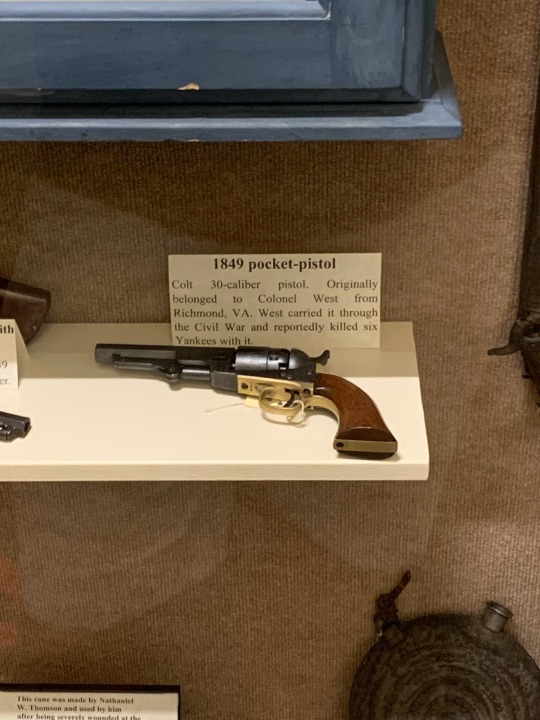
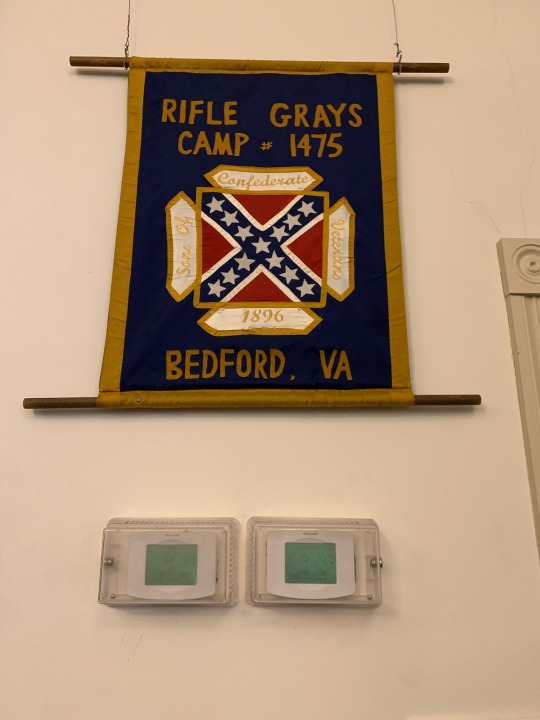
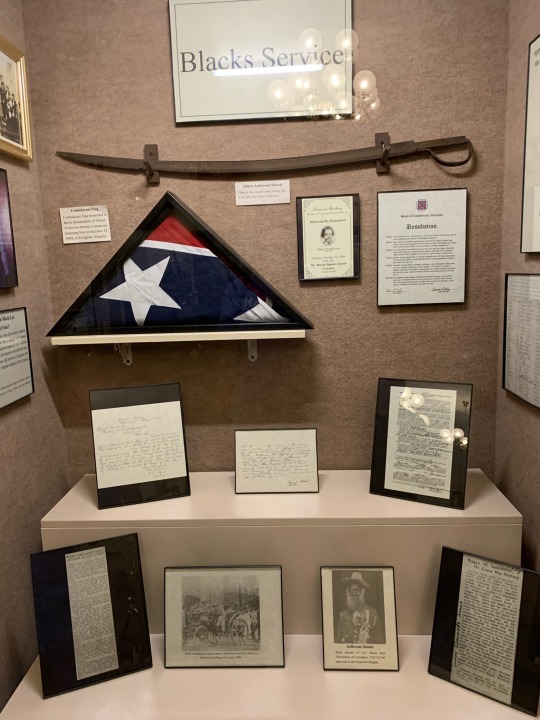
Before we left the town of Bedford, we took a close look at the Confederate monument that stands in front of the Bedford County Courthouse. The text at the base of the high obelisk below a carved battle flag says “Bedford honors her heroes; proudly rejoicing with the living; sincerely mourning the dead. Their history is its brightest pace...This stone is erected to keep fresh in memory the noble deeds of these devoted sons.” Obviously, this monument reeks of the lost cause and does not honor a piece of history that all can be proud of. Taking down such a problematic statue would not be “erasing history,” as Bedford supervisor candidates stated in 2017. The public should play a role in discussions of what to do with the obelisk, but it certainly does not belong in front of such an important government building. Once again, the United Daughters of the Confederacy supported the construction of a heinous monument at a time (1909) when African-Americans faced acts of discrimination and bigotry. If people were able to put themselves in the shoes of those most affected by the presence of such an awful monument, then we would finally be able to make lasting changes for the betterment of us all.
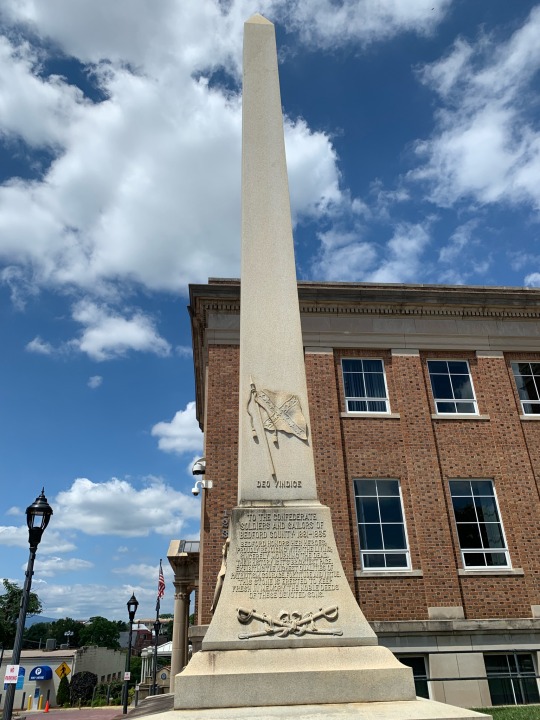
0 notes
Text
Top 5: Nostalgia Movies
This Top 5 is taking a trip down childhood memory lane to choose the best Nostalgia Movies - films that I loved as a kid and continue to love to this day. The film must have been watched multiple times during my youth and continue to be associated with a memory or tradition that was an important marker of growing up. Therefore, any film produced past 2004, when I graduated high school, has not been considered - and, to even make the cut, the film must be associated with more than just constant re-watches in our downstairs rec room (arranged with a HUGE - well, big for the ‘90s - screen with actual surround sound that my dad installed); rather, these films must be an essential part of my childhood progression into adult-hood and laid the groundwork for a future of loving cinema.
Gibelwho Productions Presents Nostalgia Movies:
5. Ferris Bueller’s Day Off
4. X-Men
3. The Little Mermaid
2. Indiana Jones and the Last Crusade
1. Newsies
Ferris Bueller’s Day Off (1986): As my high school career began to wrap up and I was looking ahead to college (where I had already committed to attending film school), my mother informed me of a proclamation - I was not allowed to leave her household without watching Ferris Bueller. Perhaps she knew that she needed to instill a little bit of rule-breaking encouragement into her straight A / type A child before I was to head out into the unruly world of college, but nonetheless, this film left a mark with it’s delightful adventures of Ferris, Cameron, and Sloane. Years later, I attended an LA rooftop screening where the audience all danced during the Twist and Shout parade, bringing me straight back to the joy of discovering this film with my mom. In the same tradition, I will be sure to make my kids watch this film before they leave our household for the wide world so they can learn to cause a little innocent rule-breaking. Save Ferris!
X-Men (2000): I had a secret obsession when I was a kid - I LOVED Marvel Comics. I had read all of my dad’s comic book collection from when he was a kid, I started my own collection, and had even started tracking the value of each issue. But I was a girl, and did not share this particular passion with my fellow elementary school friends (ahhh, the fear of being judged by your peers). So when I entered a movie theater as a freshman in high school (with my secret still intact) to see an X-Men film and the place was PACKED, I couldn’t contain my excitement that maybe, just maybe, more people would be into these characters and storylines. Then, when I went into my summer theatre program and my friends used X-Men characters as improv inspiration, I thought...this is going mainstream! I still didn’t confide my true colors until the MCU began and my college friends discovered that I knew a...lot more about Iron Man’s backstory than should be possible and I was officially outed. So, fully embracing my nerdom, I traveled to San Diego to the sacred ground that was Comic Con, truly cementing my love of Marvel. And now the rest of the world has caught up to why these characters are so special. That first inkling of a wider world loving what I loved started when I watched X-Men in theaters - seeing my heroes on the big screen, fighting their super villains, and the packed crowd around me was digging it!
The Little Mermaid (1989): One of my earliest memories of opening presents was from my 6th birthday, sitting in the living room and ripping open the wrapping paper to discover the VHS for The Little Mermaid - a film I had seen at school and LOVED - and now it was mine to watch at any time! Truly a special Disney moment, which is also matched with many other memories of Disney animated films (the momentous opening to Lion King and the cut to black that took my breath away in the theater, playing the Mulan soundtrack on cassette over and over singing Reflection, and identifying with Belle’s obsession with reading). I was very much the target audience for the Disney Renaissance, and I ate up all the music, the (slightly) stronger portrayal of women, and our VHS collection only grew to include all of these modern classics. The Little Mermaid kicked off a golden age for Disney Animation and little Katie grew up on the Alan Menken soundtrack.
Indiana Jones and the Last Crusade (1989): Our family had three fancy VHS boxed sets for three different franchises and we watched these flicks on repeat - Star Trek movies (TOS with Kirk and Spock), the Star Wars trilogy, and the Indiana Jones films. Literally any one of the movies from these collections could make this slot, but since both of the Star franchises have already gotten love in these Top 5 lists, I’m going to pick representation from our resident archaeological professor / international adventurer. My favorite of the bunch is the third - from the thrilling opening of young Indy, to the dynamic between father and son, and the epic ending of selecting the correct Grail (“you have chosen...wisely”). Watching any one of these films is just comfort food for my soul, taking me back to the family settling in to watch in our downstairs rec room, setting the foundation for the nerdom that my parents instilled into me at a young age and that has continued to guide my interests and movie-watching to this day.
Newsies (1992): Growing up, my family had Friday movie nights, where we ordered from the Pizza Hut that was right next to a Blockbuster; my brother and I were allowed to each choose a movie to rent for the weekend. I went through a phase where I just rented Newsies on repeat. It was as though this film was made just for me - a musical, set in a historical time period, with cute boys singing and dancing, music by the magical Alan Menken - what is not to love?!? I was so obsessed with this movie that in the pre-Internet age, I wrote down the lyrics by meticulously listening, pausing, writing down, rewinding, and repeating - which was an onerous process when one was working with manual VHS tapes. I eventually got a copy of my own, the DVD when it came out, the CD of the soundtrack, and also the piano sheet music. I knew all the lines to the songs, and could probably to this day quote the majority of the movie. Years later, imagine my delight when Disney produced a Broadway musical of the movie - we took a special trip to New York on my birthday to see the show (which of course, doesn’t match up to my love for the film, the true effect of a nostalgic love for a piece of your childhood). Living in LA affords us the opportunity for magical movie-going experiences, and my husband and I scored tickets to a special showing of Newsies at the Disney El Capitan theater - and then the traveling Broadway company of Newsies the musical that was in town and performing just up the street at the Pantages theater made an appearance and performed for the audience after the movie wrapped. This film has held a special place in my heart and is the epitome of nostalgia love for a movie from childhood.
Honorable Mentions:
The Music Man (1962): The two music genres we listened to growing up were 90s country (Garth, Reba, Trisha, Wynonna!) and also musicals. Our family was very much into theater and starting at the age of twelve, I started acting in musicals at our local performing arts program for youths. Our family also watched many of the classic musicals that were filmed in the 1950s and 60s, such as Hello, Dolly, Oklahoma, and Music Man. This last film stands in as a proxy for all those classics, but was also selected in particular because I performed in a production during a summer in junior high, where I was in the background chorus (and featured in the Wells Fargo song!). The music and lyrics of this story, written by Meredith Wilson, are of such cleverness and variety - from the 4-part harmony barbershop quartet to the love song ballads, the pre-hip hop rhythmic talking song to the genius opening number of the salesmen on the train. The translation to film is serviceable and very much in the style of the musicals brought from stage to screen in the 1960s - nothing too clever and some blocking that sought to recreate a theater stage on the film set, but these series of musical films cemented my love for the genre in an accessible way just as I was starting myself to perform on stage.
Jurassic Park (1993): Oh, the raptor in the kitchen stalking the two kids stills brings me chills thinking about it. Watching that scene as a kid, I (more than once) fled the room because it was so scary! This film had it all - creepy dinosaurs, a smart teenage girl and an even smarter heroine that was a scientist, great music (whose theme I diligently learned how to play on the piano), and plenty of action! My family definitely had this on repeat in the VHS player, but I loved the movie so much that I ended up reading Michael Crichton’s novel to experience the source material - and became more aware of how a film is an adaption of a novel’s storytelling, translating from the page to the screen. I do fall in favor of reading the novel before seeing the movie, but if a film helps you discover an incredible book, it can be like diving into an extension of the world beyond what the screen can fit.
3 notes
·
View notes
Text
Loss of the chance of life
A while ago I found out my grandmother was one of the many native american women who were forcibly sterilized. I wrote this article.
In 1972 Janet Clifton, an Osage woman, walked into the IHS in Clairemore, Oklahoma. For years she had been having severe pelvic cramps and they had become too much to bear. She was put in a gown and lead to a room in which sat the dreaded stirruped chair many women have despised since it’s invention. The anxiety is understandable even in modern times when women’s healthcare is arguably the most advanced it’s ever been. It’s frightening, then, to imagine approaching that chair in the 60’s and 70’s, when modern women’s healthcare was in it’s infancy, and for a Native American woman, it could be absolutely terrifying.
When Janet signed in to the clinic, she’d been asked the usual questions, one of which was ‘are you married’, which she was, and was asked if she had any children, which she did. Three to be exact. She was only twenty-five and all her children were born just under three years, so it is no surprise that when she was asked if she was religious she replied that she was Catholic. Christianity and native Americans have a strange relationship. The religion was used to justify atrocities done to us too numerous not only for this paper, but for anyone to ever list. Arguably it’s greatest crime was to mold itself into a cardboard beacon, offering native Americans sanctuary from it’s own ugliness. For centuries Native American men made the decision to convert for the rest of the family. The rules of life changed for them, but it’s unclear if they realized the changes it meant for their wives. Their roles in many nations were reduced, as was their agency over their bodies. Contraceptives in their earliest days were known throughout the world, including the Americas, yet now they were forbidden. As ridiculous and ineffective as they could be, they at least offered the illusion of body autonomy, mostly for women.
When Janet went to the IHS the Women’s Health Movement (WHM) had only recently begun, along with second wave feminism. It spoke loftily and justly about abortion rights and about changing the traditional maternity ward practices into more family oriented ones, with the fathers allowed in the delivery room. There was a resurgence of midwifery. However, these improvements did not scratch the blood soaked surface of Native American health care. As Janet lay in the chair, three white doctors entered the room. The Indian Clinic did not have any native doctors, so doctors were driven in from nearby Tulsa Oklahoma, thus continuing the tradition of white doctors working with an exclusively non-white clientele. “I felt like I was being experimented on,” she would later say. She would be in good company. A Google search of “experiments on native women” will instantly bring up several articles about the forced sterilization of Native American women, and many give examples of experimental procedures that were performed in front of many doctors under the guise of research. Janet, who only wanted treatment for what we now know as polycystic ovary syndrome, never knew she would join their ranks. “One of the doctors told me that they were going to burn the cysts off. The procedure was never really explained to me and it was probably a combination of me being a woman and being Native American. They thought I was too dumb to understand anyway.” Had she known more on the subject she might have thought he was referring to a ovarian wedge resection, a common treatment at the time. It involves opening the patient up in an operating theater and exposing the ovaries. The cysts are then carefully removed with a cauterization tool not only keep the cyst from bursting, but to ensure the ovary heals properly. Instead of doing this, Janet and her doctors remained in the exam room where he gave her a local anesthetic, inserted a cauterizing into her vaginally, and performed what was most likely a tubal litigation. This is the most common form of female sterilization and only severs the fallopian tubes. My grandmother’s painful ovaries would remain untouched and untreated.
“I remember smelling something burning,” recalled Janet, “I looked down and saw smoke.”She was sent home directly after the procedure, unaware of what had actually happened to her and uninformed of the possible side effects. There was pain, of course, and in a candid moment she also confessed that she was never able to feel sexual pleasure with her husband again. Worst of all, because there had been no attempt to treat the cysts, and the pain that started the entire ordeal returned within weeks.
Pain seems to be woven into the fabric of every Native American woman’s life and this has not gone unnoticed artists, native and non-native alike. When native women are not posing nude on a biker’s bicep, we are huddled into blankets, riding our horses, our backs bent and heads hung low. Sometimes we stand on hills, gazing at nothing with blank faces and sometimes we kneel by our tipis and look at the ground. Though the past few decades have brought forward more animated depictions of Native American women, my grandmother’s house was filled with the old fashioned kind. As a child, I thought they were pretty, if boring. I never perceived any greater meaning than a woman simply looking down. Maybe she was watching a bug. As a child I was also blissfully unaware of the majority of the atrocities faced by our people and what I did know, I largely new in name only. It wasn’t until I grew older that I’d look at these paintings and think ‘huh, she actually looks kinda sad’. Now I look at these paintings and think ‘she looks utterly defeated’. Knowing what really happened to us makes me notice details I never had before, like how so many of them have textbook thousand yard stares while portraits of chiefs and warriors in the same stye still seem to have fire in their eyes. The men are also more likely to be depicted upright, whether standing or on horseback, still tall in some way or another. The woman have deflated. We slump over our horse’s necks, we kneel, we sit. It seems as though these women have accepted that pain is just something they must endure silently and with dignity, whatever the source. My grandmother is not like these women, so when the pain that had sent her to the doctor in the first place returned, so did she.
The doctors made little effort with pretense this time - she would have a hysterectomy and that was that. At this point there was no reason to try and treat her as Janet could no longer have children, and in the end her hysterectomy would succeed in ridding her of her pain. Why then does it seem to hold so much more significance? European invaders managed to erase many aspects of various indigenous cultures, but some roots run too deep to be completely torn out and in so many of our cultures it was the female ability bring forth life that created the world. The association with women and new life was so strong that even in some nations it was observed that women sewed the seeds for the new crops and tended to them, but it was the men who reaped them. Their reasoning was that women brought life, and men took it. Some Lakota Sioux would not acknowledge a girl’s transition to womanhood until she has had a child. This doesn’t mean that a woman’s only value was her ability to have children and in many nations women held high political power, were religious leaders, and even warriors. Still, it is virtually impossible to completely separate a woman’s potential reproductive capabilities and how she was viewed in societies that place more value on the concept of new life, birth, or rebirth. So many Native American nations fell into this category, and on some level or another, a woman’s womb was sacred. In 1972, at age 25, my grandmother’s was ripped from her body.
From an outsiders perspective, it seems as though these sterilized women have become those broken women from the paintings. In doing research for this paper, I found very little. The ambiguity is unsettling. Is the near total absence of initial medical documentation a result of apathy towards Native American health, or an intentional coverup? Did the women affected not speak out about this at the time because of the taboo around reproductive systems? Was it shame, or a feeling that no one would listen anyway? I have to wonder, too, how many woman are like my grandmother who only now realizes what was done to her. Whitehorse also did not realize what happened to her until later. “I was trying to have more babies, but was having trouble getting pregnant, so I went to the IHS clinic. That’s when they told me about what they did to me,” She said. She had been sterilized during a previous surgery.“I was in so much pain when I went in for the appendectomy; they gave me a bunch of papers to sign. They never explained anything to me; I had no idea I was giving them permission to sterilize me.” she said. It wasn’t only abdominal pain that allowed doctors to trick women into sterilization. One of the more famous cases of sterilization involved two girls, both under fifteen years old, who were sterilized during surgery to remove their tonsils. It’s been estimated that between 1960 and 1970, for every seven native babies born, one woman was sterilized, culminating in roughly 25% of the potentially fertile female population. Even this was not enough of an attack on the Native American woman. Native American boarding schools, run by the BIA (Bureau of Indian Affairs) where still common in that era. A 1971 census stated that approximately 35,000 Native American children lived in boarding schools rather than at home. In these schools, children were stripped of their language, their culture, their religion, their names, and often, their sanity. Abuse was rampant and the chances of escape were bleak. While non-native children were begging for bell bottoms and watching t.v, two native boys fled, only to freeze to death in their attempt to return home. Suicide rates amongst teenage boarders could reach as high as one hundred times the national average. The rest of the nation, if it noticed, soon turned away and continued to focus on disco. Native mothers could do little to stop the abuse of their children, but a growing number were being offered a choice. If they agreed to be sterilized, their existing children might be allowed to stay with them. It can’t be said if it was in defeat or defiance that a mother made her choice, whichever it was. It would a lie to say that no woman was defeated, and sat slumped over a bottle of whiskey rather than a horse.
However, when my grandmother was wheeled into the recovery bay, she discovered that she was not the only woman who refused stoop down and be silent, though she did not yet know what bond she shared with these women. They were a small group, all in various stages of recovery. They smiled and chatted if and when they could, and because the nurses were about as helpful as a match under water, they tended to each other. The women adjusted each others hospital beds by hand, fetched each other glasses of water and just as importantly, they kept each other in good spirits. Decades later, Janet will still smile and laugh when she remembers a woman that was truly fed up with the barely edible hospital food. “You guys want some pizza?” The woman had asked, and then she got up and climbed out the window. A while later she returned the same way, pizza in hand. They might have been neglected and in pain, but in that moment they were normal women diving into a pizza and giddy with their own mischief. It seems like such a small gesture, valuable in that it’s a light hearted tidbit from an otherwise tragic story, but it is so much more than that. Expand the perspective and you’ll find it’s really the story of how a Native American woman was had her reproductive organs seared into oblivion against her will by white doctors, was neglected by nurses in a recovery room filled with strangers, and this woman still had the strength and spark to climb out a window and return with pizza to share with her sisters. Our solidarity is our fortitude. Native women have an incredible ability to come together and to accomplish incredible things. One of they key elements that allows us to do this is our ability to communicate with each other, and despite what modern white hippies may think, we can’t do that with telepathy and talking animals. I would not have been able to tell my grandmother’s story without calling her and having several lengthy phone calls. This chapter of our history is in danger of being forgotten. It’s imperative we learn as much as we can, but that is not enough. It’s through communication that bond over our people’s losses and triumphs and encourage others to learn along with us. If I am to end this essay with one request, it is that when you read this chapter of our history, please read it out loud.
—- This essay is dedicate to Janet Stork, I cannot give enough thanks to my grandmother for letting me interview her. Rather than mourn her loss, she seemed happy throughout every conversation, as if she was glad that someone wanted to hear what she had to say. This is such a sensitive topic, one that would make many young students here cringe and shy away from, but my grandmother made every conversation a comfortable one. No question was off limits, there was no withholding of details. I feel so lucky to have a grandmother like her, and I’m amazed that it’s through her strength I exist today.
48 notes
·
View notes
Text
Richard Scarry’s Busy, Busy Town Read Along, Part 1

Before the main text of Busy, Busy Town begins, we have a pig emerging from a red fire truck with a fire hose.
Based on the pig’s headgear, the first conclusion we can tentatively draw is that Busy Busy Town’s fire department is so egregiously underfunded that it cannot afford basic safety equipment for its personnel.
This raises the question: who funds the fire department?
Where you live, it may be the county. Here in Connecticut, counties have been purely ornamental since 1960. All local functions are performed by the town. A town is... I don’t even know. A town is a chunk of land, which may or may not contain settlements bigger than a hamlet somewhere on it. Some towns, like New Haven, are also cities. We have 169 towns, each of which despises its neighbors, sometimes in rivalries dating back to the mid-17th century. That anyone ever gets a bridge built across a river is nothing short of a diplomatic triumph.
This is all very New England, both in emphasizing direct democracy (some towns literally do their law-making by having the entire population come to a town meeting and argue) and in involving significant quiet side-eyeing across stone fences.
New Haven, being a city, does not assemble all 130,000 of us on the Green, but instead has us elect a Board of Alders, who argue at length and with vehement vitriol about policy-making. As far as I can tell from the one Zoom meeting of the Board of Alders that I eavesdropped on, there is sufficient seething subtext to fuel a long-running telenovela.
Our budget process -- the thing that’s going to get the fire department some real helmets -- starts with the mayor’s office putting together a draft budget that includes painful and controversial decisions. The Board of Alders then argues about it for a while, develops multiple new mutual vendettas, and then produces a final budget which may or may not incorporate the mayor’s priorities, make their constituents happy, or align with mathematics as we know it in this space-time dimension.
So, being either bored or feckless, I hied myself to where the city keeps its annual budgets and took a look at both the most recent budget (which, thanks to the pandemic’s impact on revenue collection, verges on urban fantasy) and the earliest available budget, 2012-13 (the realism of which, I can’t comment on). Thanks to the internet, there’s a good chance you can do this thing in your own home place, and it’s a weirdly fascinating look into both how complex municipal operations are and how a municipality prioritizes its constituents’ needs.
I made a spreadsheet. Our biggest item, by far, in both years was education, which is a good reminder that being a big item doesn’t mean we’re over-spending. If anything, the city schools are underfunded.
The other top items are:
employee benefits
debt service (we do have too much debt)
pensions (always an issue for old cities)
police service
(finally!) fire service
It’s not surprising fire service would be a major item, as it requires both a lot of people and some expensive equipment. A thing here, though -- you know how activists will talk about how people act like defunding the police is controversial when we defund education without a second thought?
In this period, the budget for education went down by 7.79%, while the budget for police went up by 10.79%. There’s probably a lot more to this than our current (still very new) mayor’s priorities -- city budgets are loaded with things it’s impossible to shift -- but it raises questions about what our thinking has been over the intervening years. (In reality, we’re going to be spending more on schools to make pandemic-related modifications, but the money will come from one-time sources.)
Our fire fighters do have proper helmets, though, as we can determine from the one dealing with the downed electric line that fell over the Peapod delivery van. Tropical Storm Isaias was lively, to say the least.

4 notes
·
View notes
Text
Dorothy Day and her Hope-filled “Revolution of the Heart”
What a time we’re in! I’ve put my blog on hold while working on my next book, but feel the need to come back with a few pieces to “Keep Hope Alive” in these dark times. And just in time for a Dorothy Day revival! Dorothy Day, the enterprising journalist and social activist (and perhaps soon to be saint of the Catholic Church) is having something of a revival of her reputation. A new biography (Dorothy Day by John Loughery and Blythe Randolph) and a new documentary (“Revolution of the Heart: The Dorothy Day Story” by Martin Doblmeier) have put Day back in the limelight where she belongs. She’s recently appeared in the New York Times Book Review (written by prominent religion historian Karen Armstrong, no less), for an extensive New Yorker profile, and even today in the REVIEW section of the Wall Street Journal! Day’s renaissance couldn’t come at a better time, when, thanks to the pandemic, the fragility of our safety net for the poor shows itself for what it really is: benign neglect, if not downright abuse.
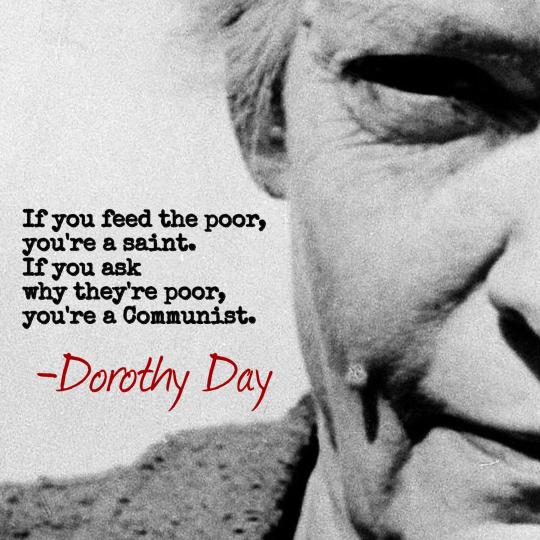
I’ve been an admirer of Dorothy Day’s for decades, dating back to my time as a Catholic seminarian in Baltimore in the 1970s when we were encouraged to think a lot about the poor and about social conditions and how best to put our social consciences to work to improve things. After leaving the seminary and trying to find my way throughout the rest of the ‘70s, I enrolled in The American University’s School of Communications and set about trying to improve my skills as a writer. While pursuing a second bachelor’s degree in Communications (the first, from St. Mary’s Seminary College, was in Philosophy), I happened upon a wonderful journalist/teacher Joe Tinkelman, who taught some of my earliest writing classes and whose consistent encouragement caused me to believe I might have a career as a writer someday.
For his “American Newspapers” class, Tinkelman pushed us to write a long-form journalistic piece profiling a newspaper of our choice. My mind immediately went to The Catholic Worker, Dorothy Day’s creation from the 1930s that was still going strong in the 1980s. I thought a 50-year retrospective was in order, so I set about to research this little-known gem and report back to Tinkelman and the class. The research I did (mostly at Catholic University) put me in deeper touch with Dorothy Day, her philosophy, her writing, and her work with the poor of New York City.
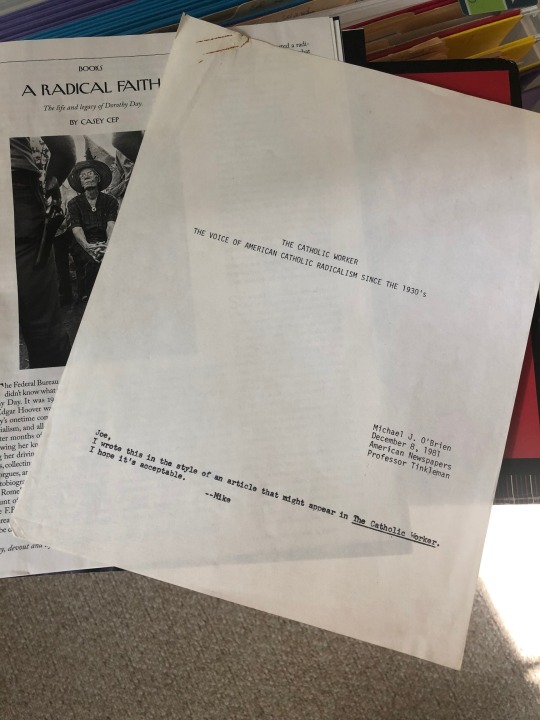
For the next four weeks, I’m posting a serialized version of the paper I did for Professor Tinkelman as a tribute to his inspiring teaching and to Dorothy Day herself and her incredible work. Read with caution: You may just get radicalized!
* * * * * * * * * * * * * * * * * * * * * * ** * * * * * * * * * * * * * * * * * * * * * * * * * *
The Catholic Worker—The Voice of American Catholic Radicalism Since the 1930’s (Part I)
By Michael J. O’Brien, 12/8/81 – American Newspapers, American University, Professor Joe Tinkelman
On a piercingly cold night in December of 1978, I stepped from the sub-compact I had so comfortably been traveling in with a former seminarian classmate of mine onto the curb of Second Avenue on the Lower East Side of Manhattan. We were on our way to Maryhouse, the Catholic Worker’s House of Hospitality for homeless women, to attend one of the C.W.’s Friday night meetings. It was my first visit to the Catholic Worker Headquarters. Before I could even close the car door, a middle-aged Black man with the smell of whiskey on his breath and of urine on his clothes—the smell of the destitute in any city—asked me for some money “for a cup of coffee.” I remember looking into this man’s half-dazed eyes, seeing behind him the lights of Second Avenue—the bars and novelty shops, the cafes and movie houses that give the street a feeling of one continuous cabaret—and wondering how to tell him on this of all nights that I could not give him a penny. [Part of our seminary training was to decline to give money to alcoholics. “They’ll only use if to further their illness,” we were told.]
I was already late for the C.W. meeting, so instead of inviting him for a bite to eat at one of those cafes, I asked him to join me at Maryhouse. I knew he would at least be warm there and perhaps could even get a cup of hot coffee. He refused, and as my friend and I dashed across the street to get to the meeting, I heard him cursing us. I can’t think, now, of a more appropriate greeting for my first visit to the Catholic Worker—a group that has served the poor and the dispossessed of the Bowery for almost 50 years.
At the time, however, I was only thinking of our lateness! As we opened the doors to Maryhouse and rushed up the stairs of this seemingly ancient tenement, I was awed by the thought that Dorothy Day, co-founder of the Catholic Worker—“both a newspaper and a movement”—graced these steps daily. For all I knew, she was there that very night, this being her primary residence in the City. I didn’t know much about Dorothy Day then, but I knew she had chosen to live her life among the poor and to serve them as if they were Christ. That was enough to spark my interest in her and in her work.
My friend and I entered the doors of the auditorium to a standing-room only crowd. More than two hundred people were packed into this tiny hall that serves as a distribution center for the newspaper and the meeting hall for “the clarification of thought,” as Peter Maurin, the Catholic Worker’s other founder, put it.
We took our places among those standing in the back and I caught a glimpse of Daniel Berrigan, the radical Jesuit pacifist, who was speaking to the throng. Berrigan was scheduled to talk that night—I guess that’s why so many people showed up—on the poetry of Thomas Merton, a well-known Catholic monk and author who died in the late 1960s. Berrigan read to us some of Merton’s poems concerning war, peace, death, and nuclear armaments. After each poem, he gave us his own interpretation of what he believed Merton was trying to convey; they had been good friends.
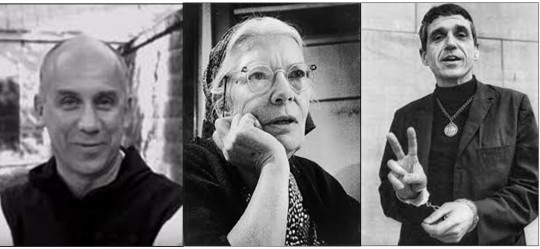
Thomas Merton, Dorothy Day, and Daniel Berrigan: Three pillars of radical Catholic thought in the 1960s.
The entire evening had an aura of unreality about it for me. Here I was in Dorothy Day’s house listening to Daniel Berrigan speaking on Thomas Merton—three pillars of radical Catholic thought represented under one roof! The history of modern Catholic radicalism came alive for me that night. It is some of that history, particularly the Catholic Worker’s singular role in its development, that I will attempt to relate in the text that follows.
The Young Radical Journalist
One could say Dorothy Day was a journalist from birth. Her father was a sports writer for the New York Morning Telegraph; her brothers became newspaper editors. Journalism was in her blood.
She became involved in questions of social justice at an early age. She read Upton Sinclair’s The Jungle and Jack London’s essay on class struggle while still in high school. One of her brothers worked on a Chicago paper (where the family lived during Day’s adolescence) called The Day Book, an experiment by Scripps-Howard that reported on the ups and downs of the Labor Movement. The paper’s accounts of the the struggles of the poor and of the workers stirred Dorothy deeply. She began to feel that her life was linked to theirs, that she had received “a call, a vocation, a direction” for her life.
Dorothy Day began her career as a journalist in 1916 at the age of 18 by taking a job at a newspaper coincidentally named The New York Call—a socialist daily that was heavily involved in the labor issues of the day. Later she worked on The Masses, a monthly Communist magazine. After the periodical’s suppression by the Attorney General during the post-World War II “Red Scare”, Day worked for The Liberator, the successor to The Masses.
Her assignments took her to all kinds of strike meetings, picket lines, and peace rallies. She interviewed Leon Trotsky while he was living in New York and writing for a Russian socialist newspaper. She picketed the White House and went to jail for a month with a group of suffragists. She counted as her friends Eugene O’Neill, the great American playwright; Max Eastman, editor of The Masses; and John Reed, author of Ten Days That Shook the World, a journalists’s account of the Russian Revolution. (The new movie REDS explores aspects of the lives of all three of these men.)
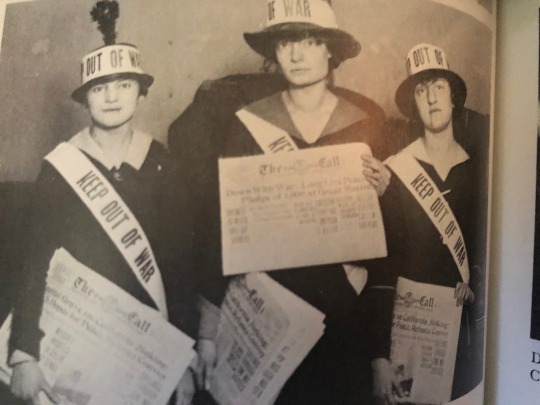
A 1917 photo of Dorothy Day (center, holding a copy of The New York Call) urging the U.S. NOT to enter WWI.
An Unlikely Convert
Although her early years as a journalist were spent advocating for causes and movements that were considered godless (Communism, after all, considers religion as an opiate), Dorothy Day converted to Catholicism in 1927 at the age of 30. She saw the Catholic Church as the church of the poor and of the worker, and she wanted to be one with them in every way. Also, she had given birth to a little girl through a common-law marriage, and the overwhelming love she experienced for both her lover and her daughter made her believe that there must be a God.
Day’s conversion caused her much suffering; she had to leave the man she loved because he would not condone her religious leanings. But she put principle before personal comfort, as she would so many times in the future.
After her Baptism, Day found she was no longer one with her comrades. They could not understand her religious convictions and she found it difficult as a Catholic to participate in demonstrations and meetings that were organized by Communists. She continued to report on the plight of the working man for Catholic periodicals—she even did a series of articles for the Catholic press explaining Marxist-Leninism!—but she felt far removed from her earlier radical involvement. She was at a loss as to how to reconcile her two great loves—her newfound love for God and her continued love for the working man and the poor.
An Answered Prayer
Dorothy Day often warned people to be careful how they prayed. “God takes you at your word,” she would say. It was through just such a prayer that she found a solution to her dilemma and that The Catholic Worker came to be.
In early December 1932, Day was covering a march on Washington, D.C., by the Communist-led Unemployment Councils. The march was an attempt by the Depression’s unemployed workers to bring their grievances to Congress. Day was reporting on the march for two Catholic periodicals, America and Commonweal. She became distressed by the march’s lack of Catholic leadership and felt she could no longer sit by and watch as others, especially Communists, took the lead in fighting for the working man. She had to find a way to get involved in the struggle as a Catholic.
On December 8, just after the worker’s march and, coincidentally a Catholic Holy Day, Dorothy Day went to the Shrine of the Immaculate Conception—still under construction in Washington—and prayed fervently that God would show her the way out of the box she was in. Remarkably, God took her at her word. When she returned home to New York, Peter Maurin, the man who was to teach her the way out, was waiting for her in her apartment.
Peter Maurin
Maurin had been sent to Day by the editor of Commonweal because they “thought alike.” He was a French peasant and was deeply rooted in Catholic social tradition. He had studied Aquinas, Augustine, and the socialy encyclicals of the Popes, as well as the many contemporary Catholic social writers, including Hillaire Belloc, Emmanuel Mounier, and the Russian activist and social theorist Peter Kropotkin.
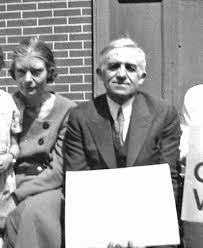
Dorothy Day and Peter Maurin sitting for a group Catholic Worker photo in the early 1940s.
Maurin had a plan for the reconstruction of the then-crumbling American society. His plan had four planks: (1) houses of hospitality for the immediate relief of those in need; (2) farming communes to relieve the wretched unemployment brought about by urban industrialization; (3) round table discussion “for the clarification of thought” on social issues; and, (4) a newspaper to get these ideas to the man and woman in the street. Maurin’s entire plan was aimed at “creating a new society within the shell of the old” where it would be “easier for men to be good.”
The Birth of a Newspaper
Dorothy Day didn’t immediately comprehend the breadth of Maurin’s thought, but she jumped at the idea of publishing her own newspaper. She found out that the Paulist Press—a Catholic publishing outlet—would print 2,500 copies of an eight-page tabloid (originally 9”X12”) for fifty-seven dollars. Day feverishly began writing articles for the fledgling paper—articles on the plight of sharecroppers, child labor, the hourly wage for factory workers, and racial injustice. These, along with Maurin’s “Easy Essays”—short, free-flowing verse for quick and easy consumption of ideas by the man in the street—made up the copy for the papers first edition.
Maurin wanted to call the paper The Catholic Radical, but because of her knowledge of Communist periodicals in the U.S., Day insisted on calling it The Catholic Worker—a direct challenge to the then-popular Communist paper The Daily Worker. “Man proposes, woman disposes,” Maurin jokingly demurred. And so, The Catholic Worker was born.
They didn’t seek permission from the Church to use the word “Catholic.” Day wondered about this, but a priest friend of hers wisely advised, “Never ask permission.”

The enduring Catholic Worker masthead
The first issue of The Catholic Worker was ready for distribution on May Day—May first, the great Communist holiday celebrating the working masses—of 1933. In a short column entitled To Our Reader, Day dedicated the paper:
For those who are sitting on park benches in the warm spring sunlight. For those who are huddling in shelters trying to escape the rain. For those who are walking the streets in the all but futile search for work. For those who think that there is no hope for the future, no recognition of their plight—this little paper is addressed. It is printed to call their attention to the fact that the Catholic Church has a social program—to let them know that there are men of God who are working not only for their spiritual, but for their material welfare.
Dorothy Day was determined to make her stand along with others involved in the workers’ struggle, so in typical in-your-face radical fashion, she along with three of her Catholic supporters went to hock the paper in Union Square, where 50,000 workers had gathered for a massive show of support for Communism. They were scoffed at and they sold few papers, but Day and her friends were satisfied with their results. The paper had been launched. In addition, Day and Maurin had embarked on the great pilgrimage that would consume the rest of their lives.
(To Be Continued)
#Dorothy Day#Peter Maurin#Daniel Berrigan#Thomas Merton#Joe Tinkelman#The Catholic Worker#American University#AU Communications#St. Mary's Seminary College#smsc
1 note
·
View note
Text
Australia is basically Jurassic Park

Australia is basically Jurassic Park. Well, at least it all looks like Jurassic Park and is probably close to as dangerous. I’m not complaining, it’s exhilirating! I’m just pointing it out…Anyway, Thursday was my last full day in Cairns. Sad. So, I decided to have a big day. I started my trip in the Rainforest and decided to end it int he same way. I started int he Daintree rainforst and ended in the Wet Tropics Rainforest. The activities included Skyrail over the rainforest, Butterfly Sanctuary, Birdworld, Kuranda Village Markets, hike through the rainforst and historic scenic railway ride back down to Cairns.
Skyrail
The skyrail is absolutely insane! It is a gondola style rail that goes for over an hour up through the Kuranda Mountain range of the Wet Tropics Rainforest. It really makes you understand how vast the rainforest here is. It is also an absolute engineering feat. It has two stops along the way to see the Barron Gorge waterfall and to have a photo op near the top of the peaks of the rainforest, before climbing even further to where the Kuranda Village is located. Founded because of the gold rush in the 1880s. It was a hippie commune in the 1960s and is now a tourist destination, since the building of the skyrail and the reopening of the scenic railway.





Barren Falls

Lookout
Butterfly Sanctuary
When I arrived in Kuranda Village, my first thought was, this is a place that people can live? They can and they do. Magical!I stopped at the markets and then headed to the Butterfly Sanctuary. I have to thank my dad for teaching me the all important skill of how to get butterflies to climb on your finger. Let’s just say, I impressed a lot of guest and got some sweet butterfly selfies out of the deal. Thanks Dad!




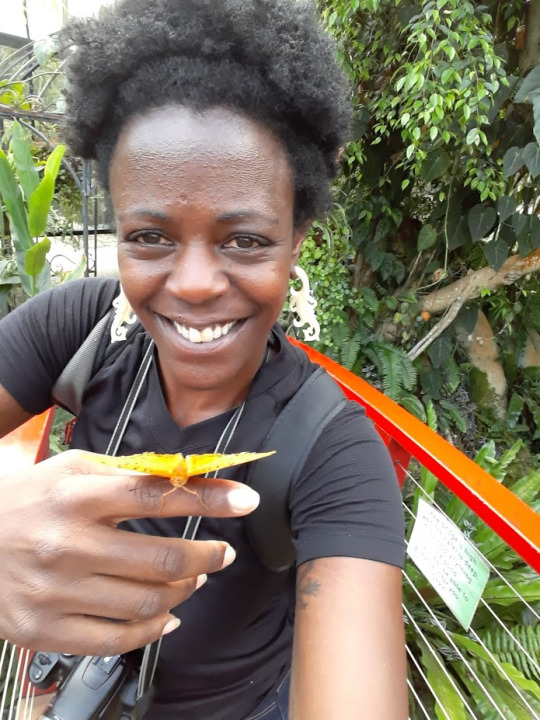


This guy tried to come home with me. Stowaeay.
Birds
Next stop, Bird World. It should have been a sign that trouble lie ahead when I had to take of my earrings and watch before I could go in. It is a big open space where birds eat seeds from your hands and land on you and try to steal anything that is not latched doen. They are very mischievious. I saw one parrot climb on a womans backpack, unlatch her carobiner and then fly away with it. Wow! They also bite, pretty hard. Once you run out of food for them, they just bite your fingers. Honestly, they are kind of assholes, but it was worth it for the bird selfies.
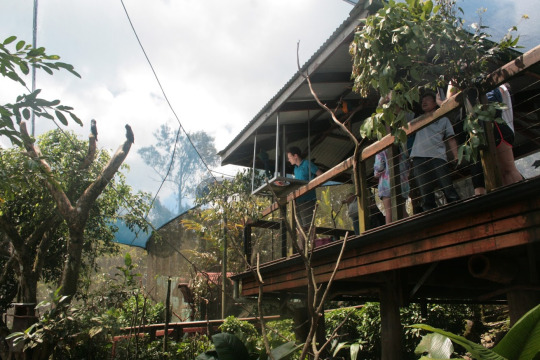
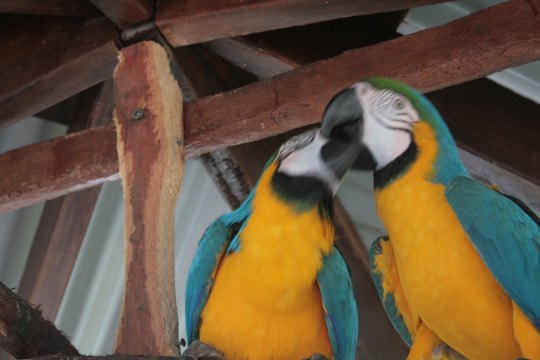
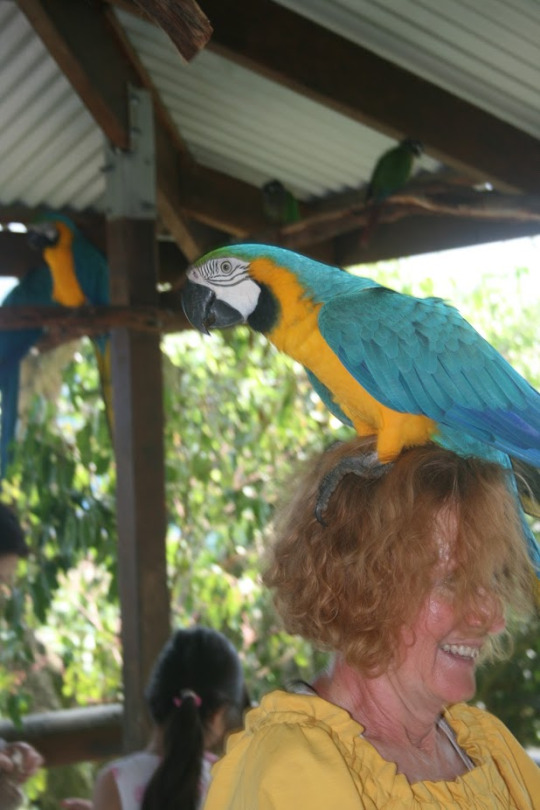


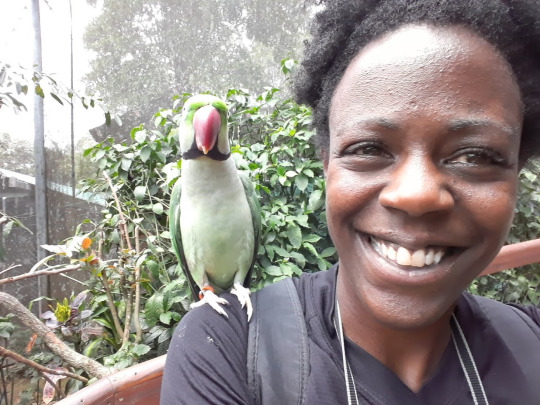
The only one that didn’t try to bite or rob me.

Wet Tropics Rainforest
My last order of business was to take a walk through the Rainforest north of the Kuranda River. For being just off the path from the main trourist area, the RRumum Creek path was beautiful. It was like I had the forest almost completely to myself Which was when I realized that Australia is Jurassic Park. I could actually envision a Velocaraptor soming out and eating me. “Cleaver girl.” For all intensive purposes, Cassowaries ARE dinosaurs. I believe they are uncomfortably genetically linked. Seems appropriate. But it was still beautiful and I’ve gotten used to being terrified all the time. It’s actually a pretty comfortable place to be these days. Absolutely beautfu place. I will miss the rainforest alot.






Rumjum Creek

Kuranda Scenic Railway
The Kuranda Scenic railway began construction in the late 1880s as a response to the gold rush and subsequent mining operations. However, the railway proved to be an engineering nightmare and took over 30 yers to complete.. The Kuranda Rail Station was one of the earliest stations built in Australia. The railway claimed over 30 lives, directly, and countless more from disease and malnutrition. The current scenic railway uses the original cars from the 1915 train and a few from the Sunshine express of the 1930s. The rail was used heavily during World War II to move munitions to the secret bases built in the jungle. For me, it was just a pleasant afternoon jaunt down the mountain back to Cairns.

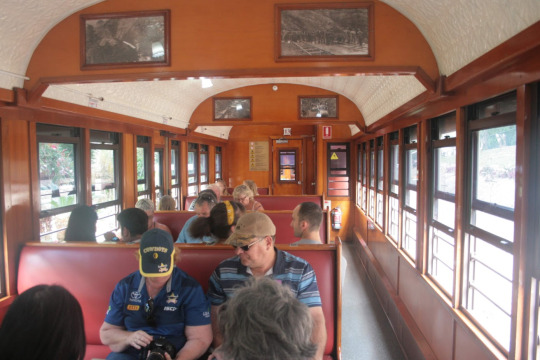




Stoney Creek Falls

Friday I will bid farewell to Australia. It's been amazing. Nextstop, Singapore. This also marks the end of my solo travels. It will be amazing to have Alicua be my tour director, but I'll miss the neverending collection tin of single-serving friends you accumulate travelling alone. They have been wonderful and generous. But on to new adventures. I will post at least once while I'm in Singapore. I'll see you all in Asia!
2 notes
·
View notes
Text
New to Me - March 2019

1890s - 0
1900s - 0
1910s - 0
1920s - 0
1930s - 2
Blonde Venus (1932)

It has been a while since I have met a character who I liked in the beginning and started to hate in the end. Helen did what she had to do to pay for her husband’s operation, however, she did him wrong in the end! She did have to make sacrifices but once she cheated on her husband and pretty much abandoned him while he was away, I became so annoyed with her. She then put her own kid in danger because she was being so selfish! The best part of the whole film was definitely the Hot Voodoo number.
Four Daughters (1938)

This was another film that frustrated me! I wanted to yell at Ann and tell her to marry who she wanted to marry and not self sacrifice because that usually doesn’t end well. Yeah, she made Mickey happy, but she was miserable! She should have just married Felix like she was going to in the first place so she wouldn’t have gone through all the crap she did. I did really enjoy seeing John Garfield’s performance though. I think I admire his acting so much that I pretty much love any of his roles.
1940s - 2
Night Train to Munich (1940)

This film was ahead of its time. I believe it was one of the earliest films to depict a concentration camp and it showed what happened right before Britain entered the war. It was interesting to see the twist in the middle of the film and to see Paul Henreid as a bad guy was such a switch! Especially since he usually plays characters against the Nazis, so seeing him as a Nazi was very different to what I was used to. This was a fun spy thriller and Rex Harrison was good as the British spy trying to trick the Nazis into freeing Anna and her father from their clutches.
Detour (1945)

How had I never seen this film before?! What a Film Noir! This was such a fantastic film! It is such a short film but so much happens in its 1 hour and 8 minute running time. Vera is such a slimy character and I honestly loved that. She has become one of my favorite femme fatales for sure. This is a must watch for Film Noir lovers. Also I hope the GIF I made makes you uncomfortable, because that was the plan.
1950s - 0
1960s - 0
1970s - 1
The Goodbye Girl (1977)

Another film that I have no clue why it took me so long to see! I am not gonna lie, I would love to find a guy like Eliot! He is so sweet yet such a goofball. I just thought this was a great romantic comedy and I recommend everyone see it because it is understandable why Richard Dreyfuss won his Oscar for his role in this film; he is so damn lovable!
1980s - 0
1990s - 0
2000s - 0
2010s - 1
Captain Marvel (2019)

This film has so much girl power and I love that! As someone who has almost seen every Marvel film (I have one I haven’t seen), this has now become my favorite Marvel film. It has an adorable orange cat (that’s a huge plus since my kitty is orange) and a badass female superhero! Brie Larson was the perfect pick for this film because she is feminine and strong. This is a must see for superhero lovers!
#classic film#film review#movies#turner classic movies#blonde venus#four daughters#night train to munich#detour#the goodbye girl#captain marvel
17 notes
·
View notes
Text
In 1972 Janet Clifton, an Osage woman, walked into the IHS in Clairemore, Oklahoma. For years she had been having severe pelvic cramps and they had become too much to bear. She was put in a gown and lead to a room in which sat the dreaded stirruped chair many women have despised since it’s invention. The anxiety is understandable even in modern times when women’s healthcare is arguably the most advanced it’s ever been. It’s frightening, then, to imagine approaching that chair in the 60’s and 70’s, when modern women’s healthcare was in it’s infancy, and for a Native American woman, it could be absolutely terrifying.
When Janet signed in to the clinic, she’d been asked the usual questions, one of which was ‘are you married’, which she was, and was asked if she had any children, which she did. Three to be exact. She was only twenty-five and all her children were born just under three years, so it is no surprise that when she was asked if she was religious she replied that she was Catholic. Christianity and native Americans have a strange relationship. The religion was used to justify atrocities done to us too numerous not only for this paper, but for anyone to ever list. Arguably it’s greatest crime was to mold itself into a cardboard beacon, offering native Americans sanctuary from it’s own ugliness. For centuries Native American men made the decision to convert for the rest of the family. The rules of life changed for them, but it’s unclear if they realized the changes it meant for their wives. Their roles in many nations were reduced, as was their agency over their bodies. Contraceptives in their earliest days were known throughout the world, including the Americas, yet now they were forbidden. As ridiculous and ineffective as they could be, they at least offered the illusion of body autonomy, mostly for women.
When Janet went to the IHS the Women’s Health Movement (WHM) had only recently begun, along with second wave feminism. It spoke loftily and justly about abortion rights and about changing the traditional maternity ward practices into more family oriented ones, with the fathers allowed in the delivery room. There was a resurgence of midwifery. However, these improvements did not scratch the blood soaked surface of Native American health care. As Janet lay in the chair, three white doctors entered the room. The Indian Clinic did not have any native doctors, so doctors were driven in from nearby Tulsa Oklahoma, thus continuing the tradition of white doctors working with an exclusively non-white clientele. “I felt like I was being experimented on,” she would later say. She would be in good company. A Google search of “experiments on native women” will instantly bring up several articles about the forced sterilization of Native American women, and many give examples of experimental procedures that were performed in front of many doctors under the guise of research. Janet, who only wanted treatment for what we now know as polycystic ovary syndrome, never knew she would join their ranks. “One of the doctors told me that they were going to burn the cysts off. The procedure was never really explained to me and it was probably a combination of me being a woman and being Native American. They thought I was too dumb to understand anyway.” Had she known more on the subject she might have thought he was referring to a ovarian wedge resection, a common treatment at the time. It involves opening the patient up in an operating theater and exposing the ovaries. The cysts are then carefully removed with a cauterization tool not only keep the cyst from bursting, but to ensure the ovary heals properly. Instead of doing this, Janet and her doctors remained in the exam room where he gave her a local anesthetic, inserted a cauterizing into her vaginally, and performed what was most likely a tubal litigation. This is the most common form of female sterilization and only severs the fallopian tubes. My grandmother’s painful ovaries would remain untouched and untreated.
“I remember smelling something burning,” recalled Janet, “I looked down and saw smoke.”She was sent home directly after the procedure, unaware of what had actually happened to her and uninformed of the possible side effects. There was pain, of course, and in a candid moment she also confessed that she was never able to feel sexual pleasure with her husband again. Worst of all, because there had been no attempt to treat the cysts, and the pain that started the entire ordeal returned within weeks.
Pain seems to be woven into the fabric of every Native American woman’s life and this has not gone unnoticed artists, native and non-native alike. When native women are not posing nude on a biker’s bicep, we are huddled into blankets, riding our horses, our backs bent and heads hung low. Sometimes we stand on hills, gazing at nothing with blank faces and sometimes we kneel by our tipis and look at the ground. Though the past few decades have brought forward more animated depictions of Native American women, my grandmother’s house was filled with the old fashioned kind. As a child, I thought they were pretty, if boring. I never perceived any greater meaning than a woman simply looking down. Maybe she was watching a bug. As a child I was also blissfully unaware of the majority of the atrocities faced by our people and what I did know, I largely new in name only. It wasn’t until I grew older that I’d look at these paintings and think ‘huh, she actually looks kinda sad’. Now I look at these paintings and think ‘she looks utterly defeated’. Knowing what really happened to us makes me notice details I never had before, like how so many of them have textbook thousand yard stares while portraits of chiefs and warriors in the same stye still seem to have fire in their eyes. The men are also more likely to be depicted upright, whether standing or on horseback, still tall in some way or another. The woman have deflated. We slump over our horse’s necks, we kneel, we sit. It seems as though these women have accepted that pain is just something they must endure silently and with dignity, whatever the source. My grandmother is not like these women, so when the pain that had sent her to the doctor in the first place returned, so did she.
The doctors made little effort with pretense this time - she would have a hysterectomy and that was that. At this point there was no reason to try and treat her as Janet could no longer have children, and in the end her hysterectomy would succeed in ridding her of her pain. Why then does it seem to hold so much more significance? European invaders managed to erase many aspects of various indigenous cultures, but some roots run too deep to be completely torn out and in so many of our cultures it was the female ability bring forth life that created the world. The association with women and new life was so strong that even in some nations it was observed that women sewed the seeds for the new crops and tended to them, but it was the men who reaped them. Their reasoning was that women brought life, and men took it. Some Lakota Sioux would not acknowledge a girl’s transition to womanhood until she has had a child. This doesn’t mean that a woman’s only value was her ability to have children and in many nations women held high political power, were religious leaders, and even warriors. Still, it is virtually impossible to completely separate a woman’s potential reproductive capabilities and how she was viewed in societies that place more value on the concept of new life, birth, or rebirth. So many Native American nations fell into this category, and on some level or another, a woman’s womb was sacred. In 1972, at age 25, my grandmother’s was ripped from her body.
From an outsiders perspective, it seems as though these sterilized women have become those broken women from the paintings. In doing research for this paper, I found very little. The ambiguity is unsettling. Is the near total absence of initial medical documentation a result of apathy towards Native American health, or an intentional coverup? Did the women affected not speak out about this at the time because of the taboo around reproductive systems? Was it shame, or a feeling that no one would listen anyway? I have to wonder, too, how many woman are like my grandmother who only now realizes what was done to her. Whitehorse also did not realize what happened to her until later. “I was trying to have more babies, but was having trouble getting pregnant, so I went to the IHS clinic. That’s when they told me about what they did to me,” She said. She had been sterilized during a previous surgery.“I was in so much pain when I went in for the appendectomy; they gave me a bunch of papers to sign. They never explained anything to me; I had no idea I was giving them permission to sterilize me.” she said. It wasn’t only abdominal pain that allowed doctors to trick women into sterilization. One of the more famous cases of sterilization involved two girls, both under fifteen years old, who were sterilized during surgery to remove their tonsils. It’s been estimated that between 1960 and 1970, for every seven native babies born, one woman was sterilized, culminating in roughly 25% of the potentially fertile female population. Even this was not enough of an attack on the Native American woman. Native American boarding schools, run by the BIA (Bureau of Indian Affairs) where still common in that era. A 1971 census stated that approximately 35,000 Native American children lived in boarding schools rather than at home. In these schools, children were stripped of their language, their culture, their religion, their names, and often, their sanity. Abuse was rampant and the chances of escape were bleak. While non-native children were begging for bell bottoms and watching t.v, two native boys fled, only to freeze to death in their attempt to return home. Suicide rates amongst teenage boarders could reach as high as one hundred times the national average. The rest of the nation, if it noticed, soon turned away and continued to focus on disco. Native mothers could do little to stop the abuse of their children, but a growing number were being offered a choice. If they agreed to be sterilized, their existing children might be allowed to stay with them. It can’t be said if it was in defeat or defiance that a mother made her choice, whichever it was. It would a lie to say that no woman was defeated, and sat slumped over a bottle of whiskey rather than a horse.
However, when my grandmother was wheeled into the recovery bay, she discovered that she was not the only woman who refused stoop down and be silent, though she did not yet know what bond she shared with these women. They were a small group, all in various stages of recovery. They smiled and chatted if and when they could, and because the nurses were about as helpful as a match under water, they tended to each other. The women adjusted each others hospital beds by hand, fetched each other glasses of water and just as importantly, they kept each other in good spirits. Decades later, Janet will still smile and laugh when she remembers a woman that was truly fed up with the barely edible hospital food. “You guys want some pizza?” The woman had asked, and then she got up and climbed out the window. A while later she returned the same way, pizza in hand. They might have been neglected and in pain, but in that moment they were normal women diving into a pizza and giddy with their own mischief. It seems like such a small gesture, valuable in that it’s a light hearted tidbit from an otherwise tragic story, but it is so much more than that. Expand the perspective and you’ll find it’s really the story of how a Native American woman was had her reproductive organs seared into oblivion against her will by white doctors, was neglected by nurses in a recovery room filled with strangers, and this woman still had the strength and spark to climb out a window and return with pizza to share with her sisters. Our solidarity is our fortitude. Native women have an incredible ability to come together and to accomplish incredible things. One of they key elements that allows us to do this is our ability to communicate with each other, and despite what modern white hippies may think, we can’t do that with telepathy and talking animals. I would not have been able to tell my grandmother’s story without calling her and having several lengthy phone calls. This chapter of our history is in danger of being forgotten. It’s imperative we learn as much as we can, but that is not enough. It’s through communication that bond over our people’s losses and triumphs and encourage others to learn along with us. If I am to end this essay with one request, it is that when you read this chapter of our history, please read it out loud.
—- This essay is dedicate to Janet Stork, I cannot give enough thanks to my grandmother for letting me interview her. Rather than mourn her loss, she seemed happy throughout every conversation, as if she was glad that someone wanted to hear what she had to say. This is such a sensitive topic, one that would make many young students here cringe and shy away from, but my grandmother made every conversation a comfortable one. No question was off limits, there was no withholding of details. I feel so lucky to have a grandmother like her, and I’m amazed that it’s through her strength I exist today.
3 notes
·
View notes
Text
Designer George Nelson: Well Ahead of the Parade
"You don't think your way to creative work. You work your way to creative thinking.” --George Nelson
George Nelson’s Early Years George Nelson was born on May 28, 1908 to Simeon Nelson and Lillian Canterow Nelson in Hartford, Connecticut, where his parents owned and operated a drug store.(1) His early childhood was uneventful. As a young man, Nelson sought “refuge in Yale’s architecture school during a rainstorm, he quickly found himself entranced by the student work on display” Nelson then decided to study architecture at Yale University. He began his studies in 1924 and “graduated with a degree in architecture [in 1928]. In 1929, Nelson was hired as a Teacher's Assistant while pursuing his second bachelor's degree [in Fine Arts] at Yale” (1). He earned that degree in 1931.(2)
George Nelson Goes Abroad The following year, “Nelson competed for and was awarded a Rome Prize, which provided a two-year stipend to study at the American Academy in Rome, where he lived from 1932–34” (3). During his studies in Europe Nelson had the opportunity to interview Europe’s leading architects, including Mies van der Rohe, Le Corbusier, and Walter Gropius among others. During his interview with Mies van der Rohe, the architect asked Nelson for his thoughts on Frank Lloyd Wright’s work. Nelson was embarrassed to admit that he was not familiar with Wright. (1)
During his stay in Rome, George Nelson married Francis Hollister. The couple returned to the United States in 1935. (1) “By [then] Nelson was an associate editor of the magazines Architecture Forum and Fortune, and the next year he was running his own architectural practice in New York with William Hamby” (3). Nelson and Hamby collaborated on a home for “inventor and industrialist Sherman Fairchild, [which] was one of the first modernist townhouses in New York” (2). The structure is set off from the other brownstones around it by its modernist façade, and it features an innovative floor plan. Nelson and Hamby’s firm closed in 1942 at the start of World War II. For the duration of the War, Nelson continued to write about architecture and design. (1)
Nelson’s writing brought him into contact with the innovative designers Eliot Noyes, Charles Eames, and Walter B. Ford.(1) During the war Nelson taught architecture at Columbia University in New York City. In 1941 he became a “member of the Architecture Committee of the Museum of Modern Art [in] New York” (4). Nelson and architect Henry Wright collaborated on the Storagewall concept and in the same year published the book Tomorrow’s House.(4) In 1942 Nelson originated the concept of “Grass of Main Street” that eventually “evolved into the [open-air] pedestrian mall” (2).
George Nelson Joins Herman Miller Nelson’s articles on design “came to the attention of D.J. De Pree, president of the Michigan-based furniture manufacturer Herman Miller” (3). Nelson designed his first collection for the firm in 1945 and was named their design director in 1947. De Pree referred to Nelson as “as someone ‘thinking well ahead of the parade’” (3). While at Herman Miller Nelson not only was responsible for designing many of the firm’s most popular furniture he, also recruited some of the most outstanding design talents of his time, “including Charles and Ray Eames, Alexander Girard, Isamu Noguchi” (2) and Harry Bertoia. (1) Nelson’s most iconic work for Herman Miller was the Platform Bench (1947), the Bubble Lamp (1952), the Marshmallow Sofa (1956), and the Swaged-Leg furniture line (1958). (2)

George Nelson, Platform Bench (1947). Image source.
George Nelson Associates is Established With money earned at Herman Miller, Nelson opened a design studio in New York City in 1947.(1,2) In 1955, Nelson “incorporated it into George Nelson Associates, Inc.” (1), and although Nelson had by this time left Herman Miller, his design firm continued to consult with the company. During this time Nelson was also “regularly [serving] as an editor for Interiors” (2). At his own firm, as he had done at Herman Miller, Nelson continued to employ the top designers of the era, “Irving Harper, George Mulhauser, Don Chadwick, Bill Renwick, and John Pile” (1) among many others. George Nelson Associates took a pioneering holistic approach to design with the “the practice of corporate image management, graphic programs, and signage” (1). An excellent example of this approach is the work the firm did for the pharmaceuticals manufacturer Abbott during the mid-1950s.(2) The company continues to use the original corporate logo today, and it looks as contemporary as ever.

George Nelson, Bubble Lamp (1947). Image source.
Nelson’s Bubble Lamp In 1947 Nelson became obsessed with a spherical Swedish lamp he had seen. He badly wanted one for his design studio, but the $125 price tag was too dear. He set about designing a spherical lamp of this own. He recalled seeing “a newspaper photograph...a fleet of ships being sprayed with a self-webbing plastic for preservation during storage” (5). What if he could design a metal frame onto which this plastic material could be sprayed? By the next day, “he had crafted a spherical metal frame and tracked down the maker of that spiderweb-like plastic” (5). In 1952 Bill Renwick a designer working for George Nelson Associates refined the lamp design which was manufactured by the Howard Miller Clock Company (not to be confused with Herman Miller). In 2016, Herman Miller obtained the rights to sell the Bubble Lamp, and it remains popular as well as affordable. Designer Johnathan Adler said of the Bubble Lamp, “It’s an atomic take on a Japanese paper lantern” (5).
American National Exhibition in Moscow Nelson was commissioned by the United States in 1959 to design a pavilion for the American National Exhibition in Moscow. The pavilion incorporated one of the earliest uses of large multi-screen presentations. The pavilion, however, became historic not so much for Nelson’s forward-thinking designs, but for being the site of Richard Nixon and Nikita Khrushchev’s ''kitchen debate'' (4).
Having divorced Frances Hollister, that same year George Nelson married Jacqueline Griffiths in 1960.(2) Not much is known about the circumstances surrounding the disintegration of the marriage to his first wife, nor are there details regarding his relationship with Ms. Griffiths.

George Nelson and Robert Propst, Action Office 1 Credenza with shelves (1964). Image source.
George Nelson and the Action Office “In 1960 Herman Miller created the Herman Miller Research Corporation under the direction of Robert Propst, and the supervision of George Nelson” (1). The purpose of the research firm was to study changes in the workplace that had taken place in the Twentieth Century and in particular how the use of office furniture evolved with these changes. “After consulting with experts in psychology, anthropology, and various other fields, Propst created the Action Office I line which was executed by” (1) George Nelson Associates. The Action Office I line was introduced in 1964, but was not successful.(6)
Nelson and Propst disagreed on the best environment to “best suit a corporate office worker” (6), so “Nelson was removed from the project” (1). Nelson’s departure allowed Propst to explore his concepts of an office space that could be modified without costly renovations. “Action Office II was based around the mobile wall unit that defines space” (6); it has become commonly known as “the cubicle” (1,6). Unlike Action Office I, the subsequent line was a resounding success. Nelson, however, always renounced the project. In 1970, he sent a letter to Herman Miller's then Vice-President for Corporate Design and Communication, Robert Blaich, deriding the dehumanizing effect of the Action Office II, which allows the office planner to pack the greatest numbers of employees in the smallest amount of space.(5)

A desk inspired by George Nelson and Robert Propst’s Action Office I Collection for Herman Miller (left) used in a set from Stanley Kubrick’s film, “2001: A Space Odyssey” (1968). Image source.
George Nelson’s Influence and Legacy In addition to George Nelson’s iconic, innovative furniture designs, he had the ability to recognize and nurture great talent in other designers. As mentioned earlier, he collaborated with designers Charles and Ray Eames at Herman Miller, and after Nelson opened his own studio, hired many designers whose work for George Nelson Associates would become iconic. Nelson’s “skill as a writer helped legitimize and stimulate the field of industrial design by contributing to the creation of Industrial Design Magazine in 1953” (1). Nelson also served as editor-in-chief of Design Journal from 1968 to 1973.(2) In 1977, he published the groundbreaking book How to See. Designer “Ralph Caplan, said, ‘He was quickly identified by all industrial designers who could read and write that he was better able than anybody to express what they did for a living and why it was important’”(4).

George Nelson Associates, Inc. for Herman Miller, attributed to Irving Harper, Marshmallow Sofa (1956). Image source.
Accolades for George Nelson George Nelson was “named a fellow of the Industrial Designers Society of America” (2) in 1966 and made a member of the organization’s board in 1969. The following year Nelson became an Honorary Fellow of the American Institute of Interior Design. He also served as a visiting lecturer at Harvard University in Boston and as a visiting professor at the School of Architecture, at Pratt Institute in Brooklyn, NY.(2)
George Nelson retired and closed George Nelson Associates in 1984. The same year he became a scholar in residence at the Cooper-Hewitt Museum.(1,2) He died in New York City in 1986.(4) In 2008, the Vitra Design Museum held a retrospective of George Nelson’s work to commemorate the 100th anniversary of his birth.(2)
References
Wikipedia.com (2 June, 2021). George Nelson (designer). https://en.wikipedia.org/wiki/George_Nelson_(designer)
George Nelson Foundation, (2012). Introduction. http://www.georgenelsonfoundation.org/george-nelson/index.html
George Nelson (1908-1986), USA: Biography and more. http://www.georgenelson.org/biographymore.html
Slesin, S., (6 March, 1986). George H. Nelson, Designer of Modernist Furniture, Dies. https://www.nytimes.com/1986/03/06/obituaries/george-h-nelson-designer-of-modernist-furniture-dies.html
Martin, H., (16 November, 2016). The Story Behind George Nelson's Iconic Bubble Lamp. https://www.architecturaldigest.com/story/the-story-behind-george-nelsons-iconic-bubble-lamp
Wikipedia.com (April 9, 2021). Action Office. https://en.wikipedia.org/wiki/Action_Office
0 notes
Link
As long as South Korea existed, its politics had a division of the right-wing and the left-wing. By the early 2000s, however, the right-wing in South Korea seemed like old news, in a literal sense. Much of its subscribers were old people whose memories of the Korean War, communist terror and desperate hunger dominated their political decisions. As they did not grow up with democracy, they worshiped South Korea’s military dictators—foremost of whom was Park Chung-hee, who ruled for nearly two decades from the 1960s to 70s—as they would a king. In this sense, they could not possibly called “conservatives,” since the term, in its strictest interpretation, presumes a liberal democratic system. “Fascists” would be the more apt description. Korea’s right-wing was contemptuous of democracy, and favored dictatorship. They favored jailing “communists,” a catch-all stand-in term for any political dissident.
But in the 21st century, the right-wing seemed like an old news. Twenty years after the peaceful democratization of 1987, it seemed that liberal democracy was the settled practice in Korea. Although the right-wing still wielded considerable force, they were aging and would fade away—or so Korea’s liberals thought. The liberals were riding high from the two consecutive terms of liberal presidents, Kim Dae-jung and Roh Moo-hyun, from 1997 to 2007. Of course, conservatism would continue to exist, but it would exist in a form that is more common in the advanced democracies: along the lines of the philosophical difference in terms of the proper role of the government, arguing over the proper size of the government, the appropriate level of taxation, regulation of corporations and redistributive policies, and so on. Even when the conservative Lee Myung-bak won the presidency in 2007, the liberals’ expectations for democratic governance continued.
It’s fair to say that Korea’s liberals were totally unprepared for what awaited them.
One cannot understand today’s Korea without understanding the internet. Until the 21st century, Korea was a middling, anonymous country. When placed among the numerous names of the world’s countries, Korea was a blank: not rich enough to command attention, not poor enough to arouse sympathy. Even the most seminal event in modern Korean history—the Korean War—is considered the “forgotten war.” Internet is what propelled Korea into the forefront of the world in the 21st century. Having seen the potential of high-speed internet earlier than just about any other world leader, Kim Dae-jung embarked on a massive project to equip the whole Korea with fiber optic cables during his term. This is perhaps the most underrated achievement of the Nobel Peace Prize-winning president. The result is the Korea of today: world leader in smartphone technology, cities constructed as a technological marvel, a major generator of the popular culture optimized for the digital age. So it shouldn’t be surprising the new breed of Korea’s young right-wing rose through the internet. What was surprising was just how retro these young right-wingers were.
The “new right wing” traces its origin to the website called DC Inside. Established in 1999, it was originally a message board to discuss the latest trend in digital cameras. (The site’s name means “digital camera inside.” It had a now-forgotten sister site called “Notebook Inside” that discussed laptops.) Soon, however, DC Inside organically grew into something else entirely. Reflecting its origin as a digital camera site, DC Inside had numerous “Galleries”—a themed message board in which people gathered to talk and, more frequently, engage in the earliest form of internet message board flamewar seen by the humankind. Particularly insane were the DC Baseball Gallery and the DC Comedy Gallery, where gladiatorial fights opened nightly to attract the amused onlookers.
The influence of DC Inside on Korea’s internet scene in the early part of the 2000s cannot possibly be overstated. DC Inside was the birthplace of every internet trend and meme. From the fires of the vulgar keyboard wars, a comedic gem would emerge. Such gem of a meme would spread into other major Korean websites, and eventually made their ways to newspapers and television. You might recognize this type of site—it’s Reddit, with Galleries being Subreddits. Reddit was once described as the “dark, unruly id of the internet,” but DC Inside was the OG of that description, as DC Inside is at least six years older than Reddit. (Note: Remember how I keep saying Korean politics is a five-year preview of US politics? Keep this in mind.)
DC Inside always was a cesspool, but even there, some truly deranged minds distinguished themselves with their over-the-top cessiness. Many of them gravitated toward DC Inside’s Comedy Gallery, then in 2010, separated themselves into their own message board site. There, they collected the most fucked up jokes, photoshopped images and gifs, and voted to choose the “best” material of the day. Thus, the site was known as the “Depository of the Daily Bests,” or Ilgan Best Jeojangso [일간베스트 저장소]. Over time, this site came to be known as the acronym of the first syllable of the first two words: Il-be.
For Korea’s young right wing, Ilbe was the demented internet version of the Viennese salon. At the first encounter, Ilbe would appear to be little more than a collection of destructive attitudes. The core of such destructive attitudes was self-loathing, in which Ilbe users wallowed and reveled. In their own telling, Ilbe users were aware of their own ugliness—the awareness which gave them a position of moral superiority in a twisted way, because everyone else who didn’t own up to his ugliness was a hypocrite. With this distorted moral license, Ilbe users engaged in a constant, nihilistic quest to create the most offensive contents possible, which in their minds would expose the hypocrisy of the rest of the Korean society. Violent misogyny, homophobia and racism were Ilbe’s mainstays.
It was only a short time before Ilbe as a whole began taking on a discernible political stance as they sketched out their identity based on self-loathing nihilism. After all, all politics is identity politics. As they hunted for the sacred cows of Korean politics, they latched onto the most sacred one: Korea’s democracy. For the nihilistic youth who wanted to destroy the legacy of their father’s generation, there was no better target. Rejection of democracy was perhaps Ilbe’s only clearly stated political goal: the “downvote” button on Ilbe’s site was called “democratize.” This made Ilbe’s politics take on a curiously retro character—curious because while Ilbe’s political gaze looked backwards to pre-democracy Korea, it did not look at the same direction as Korea’s older right wings. The hero of Korea’s older right wing was Park Chung-hee, the authoritarian who (in their minds) defended South Korea from the communists in North Korea and delivered the country from desperate poverty. But the hero of Ilbe was Chun Doo-hwan, the authoritarian who succeeded Park Chung-hee—because Chun is most prominently remembered as the one who massacred hundreds of democratization activists in Gwangju in 1980. For Ilbe users, the ability to kill the liberals was more important than the authoritarian economic development.
Recall that Korea is the world’s first wired society. Korea had cyberbullying and doxxing before the rest of the world even knew what cyberbullying and doxxing were. Korea had the world’s largest social network service long before Facebook entered Mark Zuckerberg’s imagination. So it shouldn’t surprise you that Korea had the world’s first alt-right, long before there was such a word “alt-right,” because it is impossible to conceive of alt-right without the internet. Ilbe users were the world’s first alt-right, in that it foretold central characteristics of all the alt-right movements that would come. To put it diplomatically, they were disaffected young men who, disillusioned by the establishment politics, sought refuge in the idealized version of the past. To put it more straightforwardly, they were fuckheads who indulged in their worst tendencies online, to create a type of politics that is little more than a tool for nihilistically causing pain.
And boy, did Ilbe cause pain. In the decade of conservative rule began in 2007, Ilbe gained enough strength to be one of Korea’s largest websites by 2012. Ilbe became a social phenomenon, the fountainhead of noxious ideas from which Korea’s conservative politicians gathered their talking points and spread their own. When the Sewol ferry sank in 2014 and created the greatest political crisis that Park Geun-hye faced (at least until the Choi Soon-sil scandal broke,) Ilbe took the forefront of the unbelievable task of making the parents who lost their children in the sunken ship as greedy money grabbers. In the most disgusting political theater I have ever seen in my lifetime, hundreds of Ilbe members gathered at the City Hall Square, where the parents of the Sewol ferry children were engaged in a hunger strike, to start a “gluttony strike”: eating fried chicken and pizza to taunt the parents who had been starving for days. Ilbe’s negative influence peaked toward the end of 2014, when an Ilbe user bombed—bombed!—a leftist Korean American speaker, injuring three members of the audience.
Ilbe put Korea’s liberals completely at a loss. Never in their wildest imagination could they conceive that Korea’s youths would so actively reject democracy itself. Liberals—what else?—wrote a number of books and articles, trying to process what is happening. Some blamed themselves: Park Ga-bun, in his book “Ilbe’s Ideology” [일베의 사상], claimed Ilbe’s hostility to democracy resulted from the failed promises of democratization and the civic movements. Others tried to re-affirm their liberal values, such as freedom of speech. Law professors like Park Kyung-shin of Korea University and Hong Sung-soo of Sookmyung University offered pieties about how even Ilbe members had the right for free speech.
As it turns out, Korea’s liberals were even less prepared for Ilbe than they thought they were, because they simply lacked the imagination to fathom the lengths that Korea’s right-wing would go to destroy them.
Park Geun-hye administration was a lame duck almost from the beginning. Just days before the 2012 presidential election, an agent for the National Intelligence Service—South Korea’s spy agency—was discovered in a small room in Seoul, adding internet comments that criticized liberal politicians. It was big news that came too late in the election cycle; eight days later, Park Geun-hye squeaked past Moon Jae-in to become the sixth president of the Republic of Korea in the democratic era. The Park administration spent its first year fending off charges of a rigged election. After a year of investigation, the facts revealed by the end of 2013 was enough to shock the conscience. Since 2009, in the middle of the Lee Myung-bak presidency, the NIS ran a “Psychological Warfare” division whose sole task was to attack South Korean liberals. The 70 or so agents in the Psychological Warfare division were professional internet trolls. They wrote posts on major websites, and upvoted or downvoted posts. They spammed comments until every major news story comment board was filled with their comments. They fired out more than 1.2 million fake tweets. All of these were about Korean politics, praising conservatives and attacking liberals. All of these were in foul, vulgar language—the screen name for one of the NIS agents, for example, was “Decapitate Lefties” [좌익효수].
Four years later the Park Geun-hye administration fell, through an utterly irrational scandal involving a shaman’s daughter. The incoming Moon Jae-in administration re-opened the NIS investigation—whose findings are so staggering that it defied belief.
The government actively created contents to damage the liberals. The NIS consulted psychologists to create the most damaging and humiliating photoshopped images of liberal politicians and activists. The most prominent example was the photoshopped mixture of Roh Moo-hyun’s funerary photo with a koala, designed to derisively undermine the last president’s dignity without quite stepping over the line. The Blue House also fed narratives: when the parents of the children who died in the Sewol ferry began their hunger strike, the internal Blue House memo said “take out Moon Jae-in, claim he is assisting suicide, politics of death.”

Other damage to liberals was more direct. The Lee Myung-bak and Park Geun-hye administrations blacklisted liberal-leaning celebrities, making sure they could not appear on television. The NIS even had a timetable; an internal memo titled “Expanding the expulsion of left-leaning talents from MBC,” several celebrities such as outspoken rock stars like Yun Do-hyeon and Shin Hae-chul were specifically named, with the date on which they were to be taken off the air. The government also threatened advertisers, making sure that these celebrities could not appear on their commercials. The NIS also directed a GamerGate-style attacks against liberal celebrities, using its troll army to spread false rumors about drug use.
The government also created Korea’s right-wing media. Not assisted, not subsidized, created it out of thin air. In 2009, the Lee Myung-bak administration tapped Byeon Hee-jae, a pathetic gadfly whose only claim to fame until that point was being called “a gadfly no one ever heard of” by a prominent liberal commentator, to start an online publication called Media Watch. The NIS under the Lee administration paid the seed money for Byeon to start his website. Then the Lee administration pressured corporations to buy advertisements on Byeon’s site, and also ordered government workers to sign up for Media Watch’s paid subscription. Park Geun-hye administration, for its part, pressured Naver—Korea’s analogue of Google—to bury the bad news stories from search results.
The conservative government also subsidized right-wing civic groups, using them as extra-governmental political weapons. Lee and Park administrations paid veterans groups, who in turn paid to carry in busloads of old people from the countryside to stage massive political demonstrations in Seoul. (These included the “counter protestors” to the Candlelight Protests that brought down the Park Geun-hye administration.) Again, the government simply told these civic groups what to do. Following the government’s direction, these civic groups petitioned to keep out former president Kim Dae-jung from the National Cemetery upon his death, and engaged in a letter-writing campaign to Norway to somehow cancel Kim Dae-jung’s Nobel Peace Prize.
Taken together, it was not simply that the conservative government added some trolling firepower Korea’s right wing with fake comments and tweets. Rather, the conservative government was the entire game. The conservative government created political storylines, fed them to the right-wing media that the government itself created, used the right-wing civic groups to repeat them—until they became the mainstream opinion. The dissident voices were harassed, defamed, fired, and silenced, through pressures applied to media and search engine sites.
From start to finish, the conservative government managed the entire process that created a political narrative. And the biggest beneficiary, of course, was Ilbe, Korea’s most heavily trafficked right-wing website. Ilbe was the testing tube that the NIS used to see what humiliating meme would work the best to attack the liberals. Ilbe was the never-ending wellspring of right-wing troll army, who swarmed the left-leaning celebrities the NIS directed them to attack. Ilbe was where right-wing storylines were amplified, giving clicks to right-wing media and serving as a meeting ground for right-wing groups. For all of its vile, outrageous actions, Ilbe was shielded from consequences—the Park Geun-hye administration gave the Ilbe bomber a suspended sentence while deporting the Korean American speaker.
A gardener does not bear a fruit; the tree does. But the manner in which the gardener fertilizes the grounds, prunes the branches and pollinates flowers, determines the type and quality of the fruit that the tree bears. Even without the conservative government, Korea may have developed an alt right; but the type and quality of that alt right would have been different. Without the efforts by the Lee Myung-bak and Park Geun-hye administrations to nurture it with money, and mainstreamize its voices, Korea's alt-right certainly would have been smaller, its vileness less pronounced and more firmly rejected by the rest of the Korean society. It was the conservative administrations that raised Ilbe, to harvest the most toxic fruit. Korea’s alt-right, the first alt-right of the world, was a government start-up.
the author claims Reddit as the best American parallel to Ilbe, but 4chan would probably be a better one.
incidentally, the founder of Encyclopedia Dramatica, girlvinyl, worked at a high level position in the National Nuclear Security Administration at the time she founded the site. part of her job was to work with counterintel agents.
610 notes
·
View notes
Text
The Blogfather
New Post has been published on https://walrusvideo.com/the-blogfather/
The Blogfather
He wasn’t an Arsenal fan, but he was at the 1971 FA Cup final. I wasn’t born yet (I didn’t arrive until September of that double winning year), but he saw Charlie George score that winner and lie flat on his back on the Wembley turf to celebrate.
Like so many of his generation, he came to England from Ireland to find work in the late 1950s, and I’m sure my love of football came from him. There was always a ball, always a kick-around in the garden, or on the front lawn of the castle we lived in for a while (honestly, it was a castle).
Back then you could just go to a football match. Rock up on a Saturday, and pay your way into the ground depending on who was at home. He lived and worked in West London, and nominally he was a Fulham fan. He loved Johnny Haynes, but he was a huge admirer of Jimmy Greaves too. He liked players who could do things with both feet, and he went to matches all over the city, just because he could.
Some of my earliest memories are of him playing football. He started life as a forward (like my brother), but by the time I came along and he was togging out for the village team in Bishopthorpe (near York), he’d moved back to centre-half (where I played my whole life). I’d stand on the sidelines with my mam. I don’t remember the games or the performances, just the fact that I was there and so was he.
..
He was pretty strict when we were young. I think it was because he had very clear ideas about what young men should and shouldn’t do. They should look smart, for example, and definitely not wear jeans. They really shouldn’t watch Grange Hill, because those children were basically juvenile delinquents and didn’t respect figures of authority sufficiently.
He worked a lot though, so it was often drive-by stuff. He spent most his working life in the hospitality industry – bars, restaurants, hotels. Long hours, late nights.
Once, in the back garden, I was winding my brother up, as big brothers do. He reached breaking point and unleashed a wave of expletives that would have made a sailor blush. Dad, probably trying to get a bit of rest upstairs, heard everything, stuck his head out the bedroom window and it was the most trouble any little boy has ever been in before or since. I felt bad, and I bought Tim some Cadbury’s Creme Eggs to say sorry.
..
In 1996 he was away on a golf trip in Spain and fell ill. Cardiomyopathy. The prognosis was not good. He needed a heart transplant. In the mists of time it feels like it happened quickly, but it didn’t. He spent months and months gravely unwell, in and out of hospital, but in the end they took his actual heart out and put someone else’s in.
It’s basically a miracle, isn’t it?
When you think about it, it’s absolutely crazy, but as I said at his eulogy, it changed his life and it saved his life. He became a fierce advocate for organ donation. He helped found the Irish Heart and Lung Transplant Association, and he went onto to chair the European Heart and Lung Transplant Federation. He wanted to ensure as many people as possible could benefit from the incredible medical advancements, and the work carried out by doctors and transplant teams.
As you might imagine, that kind of thing gives you a new perspective on life. He was certainly mellower post-transplant, but it coincided with us reaching a stage of adult life where your relationship with your parents changes anyway. We did a lot of stuff together. Golf, pints, dinners, holidays, even the Arsenal.
I don’t know if the trip we took to London was specifically to see a game, or if it coincided with something else, but he came with me to the Emirates to see us play in the Champions League. We played PSV and a late goal from on-loan Chelsea defender Alex saw us crash out. Not exactly a stellar night on the pitch, but it was still a good one off it. We had post-game pints in The Tollington, he met many of the Arseblog crew, and he often talked about how much he enjoyed it.
He loved Arseblog and what it became. He’d read most days. He’d say ‘Some of those chaps on the Arses are a bit fruity, aren’t they?!’. He even listened to a podcast, impressed and somewhat astonished with how often, and with such variation, Ian Wright said my name.
..
He hadn’t been well for a couple of weeks. I took him to the doctors on February 1st. She told me she was worried about his kidneys. Years of anti-rejection and immuno-suppressant drugs take their toll. Blood test results came back that afternoon. He needed to be in hospital.
I remember him waving to us from the ambulance before it pulled away, his big overcoat pulled tightly around him on a cold evening. Over the next couple of weeks he was treated for the infection, he was getting there, but slowly.
On Monday February 15th I got a phone call from a doctor. He’d been unwell, so they ran more tests. One of them was for Covid-19. It came back positive. We spent a year doing everything we could to keep him safe during the pandemic, and somehow he picked it up in the Coronary Care Unit of a hospital.
Yet over the next week, he didn’t really develop any of the major symptoms. On Monday February 22nd he called from his bed, we spoke about him coming home. He couldn’t wait to get back to his chair, in front of the fire, to watch golf and CNN. We wondered how strong he’d be, what care he might need. How we might have to adapt the house. Downstairs bedroom, stairlift, that kind of thing.
Then … day 10. Covid hit.
Did you ever get winded? It’s scary, isn’t it? Those few seconds where you can’t catch your breath. Imagine that all the time. He needed oxygen, then more oxygen, then all the oxygen it’s possible to give someone.
We were lucky in that we were allowed in to see him. We got to talk to him. That will always be a comfort, but seeing your dad on his own in a six bed ward, surrounded by and attached to machines, struggling to breathe is brutal. You want to help somehow, but you can’t.
We were clad in so much PPE, gown, masks, goggles, gloves, that he thought we were doctors at first. Maybe that’s why he told ‘them’ he didn’t want to die in hospital.
He died in hospital … in the early hours of March 2nd.
He’d been through so much. The heart transplant, he beat a lung cancer situation, he had an ongoing prostate cancer situation, but he couldn’t beat this. He was 84 and he’d lived a good life, but it doesn’t make it any easier to see someone you love die like that.
I’m not going to preach to anyone, but I can only urge you to be cautious. I know we’re all fed up with restrictions and life being the way it is. I know there is light at the end of the tunnel as vaccines are being rolled out, but this virus is still out there and it’s still dangerous. The most vulnerable among us are still loved and cherished family members and friends. Please don’t lose sight of that amid frustration, we all have a responsibility to each other. Someone’s age or their underlying condition doesn’t make them expendable.
Be careful. Look after each other. Each one of those statistics released daily is a real person, with many more left behind. Wash your hands. Wear a mask – at worst it’s a mild inconvenience, at best it saves lives, maybe even your own. Get the vaccine when you can.
My daughter, who I haven’t seen in person for over a year now, couldn’t get home for her grandad’s funeral. The funeral at which only ten people were allowed. That’s not how we do things in Ireland. There was no wake, no telling of stories about the one just gone. The laughs you have at events like that seem incongruous to the situation, but they’re a big part of how get through it.
Like so many other families over this last 12 months, we were apart at a time when we needed to be together. Just a couple of weeks previously my big cousin Adrian, a Gooner and only a few years older than I am, was taken by Covid too. He wasn’t elderly, he wasn’t high risk. I had to ring my dad in hospital and tell him, and while the staff in there were so lovely, he had nobody to share that grief with in person.
The support mechanisms we have in place to cope with things like this aren’t there any more. There are very obvious impacts of Covid on our lives, but there are malingering ones which I don’t think we’ll come to understand for some time yet.
..
Whatever nurses are paid, they deserve twice that, and more. They are amazing. They don’t need to be clapped, they need to be paid properly. You might not need them now, so perhaps they don’t register, but there will come a time when you will, and they will be amazing for you and your family too.
They shouldn’t have to fight for the compensation they deserve. We should be fighting for them. We should be angry on their behalf. Fight for healthcare.
Pay them properly.
..
My dad was an amazing man. Really funny, kind, generous, a good person who was the linchpin of our family, and we’re going to miss him terribly. He was well cool too, I mean, look at that 1960s shades/rollneck action he had going on.
I’m experiencing a lot of emotions right now, and it’s going to take some time to process, as they say. Today though, I just want to remember him in a positive way. A man who had a huge influence on who am I, someone who – when I think of him – makes me smile.
It’s absolutely shit he’s not going to be around anymore, and the circumstances of his passing were deeply unpleasant. It’s been a really rough few weeks, to be honest. However, he gave me the strength to get through this, and on this Arsenal blog I’m gonna take the owner’s privilege and set myself up with a tap-in to finish.
Love you Dad, and as a wise man once said, you were f*ckin’ excellent.
The post The Blogfather appeared first on Arseblog … an Arsenal blog.
The Article The Blogfather First Appeared ON : https://arsenalweb.co.uk
The Article The Blogfather First Appeared ON : https://gqcentral.co.uk
#gallery-1 margin: auto; #gallery-1 .gallery-item float: left; margin-top: 10px; text-align: center; width: 33%; #gallery-1 img border: 2px solid #cfcfcf; #gallery-1 .gallery-caption margin-left: 0; /* see gallery_shortcode() in wp-includes/media.php */
Go to Source Author: Goldie
0 notes
Text
RESPECT FOR TRUMP DIMINISHING
It cannot be denied Trump continues to be a power. Though things are happening that reflect the power diminishing. As respect for him diminishes, so too does his power.
One example is Truth Social. Trump announced this week his personal social media was in the process of becoming a reality. Its purpose to follow the truth. What a joke!
The site would officially begin in November. However Trump immediately posted a test version where people could sign in merely by providing their names.
The fact that the site will provide Trump with broad access is a disgrace. His large number of followers will subscribe. He will have immediate access to them and the world via the site. It will be Trump’s tool to spread lies.
Though despicable in itself, Trump will reap a harvest.
Trump is doing the project with DWAC, a special purpose acquisition company. DWAC sells stock with the intention of buying private firms. The announcement reported DWAC would invest $293 million in the Trump project.
The announcement caused the price of he stock to triple in one day.
A major DWAC investor SABA Capital announced it was bailing out and selling all its stock. It wanted nothing to do with Trump. SABA’s principal said the the decision was “not even a close call.” Some people will not go to bed with dogs that have fleas.
Another “adverse” occurrence is Trump’s new site has already been hacked. Within hours, the unreleased test version was invaded. A picture of a defecating pig posted to the “donaldjtrump” account.
Truth Social was pulled off line immediately.
The site will return with all the necessary bells and whistles to hopefully protect it from similar hacking in the future.
The House of Representatives voted yesterday to hold Bannon in criminal contempt. Nine Republicans joined with the Democrats in the voting. The matter is now in the hands of the Attorney General as to whether the criminal contempt charge should be presented to a grand jury.
What a waste of time! The matter should be moving swiftly. Not doing so. I worry Merrick Garland will take forever and in effect sit on the contempt charge forever while deciding what to do.
Recall several months ago I warned of my concern when Garland’s nomination for Attorney General was announced. An honorable man without question. However, an appellate judge for more than 20 years. I advised my concern that a judge who served that long was not the best choice to be a prosecutor. His thought process had changed in those 20 years.
My fear was that in crossing every t and dotting every i, Garland would take forever in getting things done. And now as far as Bannon is concerned, decide in the final analysis Bannon should not be criminally cited.
My concern was reflected yesterday when Garland apparel before the House Judiciary Committee. He expressed his concern for the “jail problem” as Bannon’s contempt matter might affect it. He explained something we all know. The jails are full off gangs. Some whose members on the outside may have been perpetrators on January 6.
Were they to be arrested and convicted, the jails would have increased problems as a result.
Not the way to think! The judicial system was not set up to worry about impacts resulting from arresting someone. The way it is done is to arrest forthwith and convict a perpetrator and thereafter deal with the resulting problem.
No one should be permitted to spit in the face of the United States and get away with it. Bannon was and is part of the January 6 problem. The subpoena should have been approved by Justice yesterday.
These are dark days. So many things either not moving in orderly fashion or not not moving at all. Most elected officials by their actions reflect little care for their country. And more. Everything is a mess government wise.
There is a need for joy in the land. A smile. Some kumbaya.
Several months ago, I shared with you the Italian Grocery Store video. A happy work. Provided me with a smile and laugh.
I am replaying the video today. I hope it brings you some momentary joy.
http://keywestlou.com/wp-content/uploads/2021/01/Italian-Grocery-Store-3.mp4
Enjoy your day!
RESPECT FOR TRUMP DIMINISHING was originally published on Key West Lou
0 notes